Optimization Models under Uncertainty in Distributed Generation Systems: A Review
Abstract
:1. Introduction
- –
- Update the state of the art in the optimization of DGS under uncertainties, encompassing the most relevant articles written in the last five years and identifying the most recent trends;
- –
- Perform an exhaustive classification of the state of the art, based on microgrid architecture, sources of uncertainty (SoUs), uncertainty addressing methods (UAMs), problem type, objective function, problem formulation and optimization algorithm, which exceeds the scope of other reviews;
- –
- Discuss the ideas in the reviewed articles and develop a meta-analysis to quantify their relative impact in the field.
2. Methodology
3. Microgrid Architecture
4. Uncertainty Characterization
4.1. Sources of Uncertainty
4.1.1. Renewable Generation
4.1.2. Load
4.1.3. Electricity Price
4.1.4. Islanding Events
4.1.5. EV Availability and State of Charge
4.1.6. Economic Parameters
4.2. Uncertainty Addressing Methods
4.2.1. Sensitivity Analysis and What-If Analysis
4.2.2. Probability Distribution Functions (PDF)
4.2.3. Time Series
4.2.4. Risk Measures
4.2.5. Uncertainty Budget
4.2.6. Point Estimate Method
4.2.7. Machine Learning (ML)
4.2.8. Fuzzy Logic
4.2.9. Markov Chains
5. Mathematical Model Classification
5.1. Problem Type
5.1.1. Day-Ahead Energy Management
5.1.2. Online Management
5.1.3. Sizing or Design
5.1.4. Trading
5.1.5. Expansion Planning
5.2. Objective Functions
5.2.1. Economic
5.2.2. Environmental
5.2.3. Reliability
5.2.4. Multi-Objective Approaches
5.3. Problem Formulation
5.3.1. Classical
5.3.2. Scenario-Based
5.3.3. Two-Stage Stochastic Programming (2SSP)
5.3.4. Multi-Stage Stochastic Programming (MSSP)
5.3.5. Robust Programming
5.3.6. Chance Constraints
5.3.7. Rolling Horizon (RH)
5.3.8. Model Predictive Control (MPC)
5.3.9. Game Theory
5.4. Optimization Algorithm
5.4.1. Linear/Mixed Integer Solver
5.4.2. Convex Solver
5.4.3. Nonlinear Solver
5.4.4. Metaheuristic Algorithms
5.5. Additional Features
5.5.1. Grid Model
5.5.2. Battery Aging Model
5.5.3. Demand-Side Management
5.5.4. Correlation
5.5.5. Linearization
5.5.6. Decentralization
6. Discussion
6.1. About the Future of Dealing with Uncertainty
6.2. About the Articles’ Main Contributions and Trends
6.3. About the Relative Impact of the Field (Meta-Analysis)
7. Conclusions
Author Contributions
Funding
Institutional Review Board Statement
Informed Consent Statement
Data Availability Statement
Conflicts of Interest
Abbreviations
| 2SSP | Two-stage stochastic programming |
| ADMM | Alternating direction method of multipliers |
| ADS | Active distribution system |
| ANN | Artificial neural network |
| ARIMA | Autoregressive Integrated Moving Average |
| ATC | Analytical target cascading |
| CP | Convex programming |
| CVar | Conditional value at risk |
| DGS | Distributed generation systems |
| EBITDA | Earning before interests, tax, depreciation and amortization |
| EV | Electric vehicle |
| LP | Linear programming |
| MILP | Mixed-integer linear programming |
| MPC | Model predictive control |
| MSSP | Multi-stage stochastic programming |
| NLP | Nonlinear programming |
| NPV | Net present value |
| Probability distribution function | |
| PEM | Point estimate method |
| PSO | Particle swarm optimization |
| RE | renewable energy |
| RH | Rolling horizon |
| SoU | Source of uncertainty |
| SVM | Support vector machine |
| ToU | Time-of-use |
| UAM | Uncertainty addressing method |
References
- European Parliament. Legislative Train Schedule: Fit for 55 Package under the European Green Deal. 2019. Available online: https://www.europarl.europa.eu/legislative-train/theme-a-european-green-deal/package-fit-for-55 (accessed on 15 July 2021).
- Schelly, C.; Bessette, D.; Brosemer, K.; Gagnon, V.; Arola, K.L.; Fiss, A.; Pearce, J.M.; Halvorsen, K.E. Energy policy for energy sovereignty: Can policy tools enhance energy sovereignty? Sol. Energy 2020, 205, 109–112. [Google Scholar] [CrossRef]
- Hirsch, A.; Parag, Y.; Guerrero, J. Microgrids: A review of technologies, key drivers, and outstanding issues. Renew. Sustain. Energy Rev. 2018, 90, 402–411. [Google Scholar] [CrossRef]
- Li, R.; Wang, W.; Chen, Z.; Jiang, J.; Zhang, W. A review of optimal planning active distribution system: Models, methods, and future researches. Energies 2017, 10, 1715. [Google Scholar] [CrossRef] [Green Version]
- Ehsan, A.; Yang, Q. State-of-the-art techniques for modelling of uncertainties in active distribution network planning: A review. Appl. Energy 2019, 239, 1509–1523. [Google Scholar] [CrossRef]
- Jordehi, A.R. How to deal with uncertainties in electric power systems? A review. Renew. Sustain. Energy Rev. 2018, 96, 145–155. [Google Scholar] [CrossRef]
- Talari, S.; Shafie-khah, M.; Osório, G.J.; Aghaei, J.; Catalão, J.P.S. Stochastic modelling of renewable energy sources from operators’ point-of-view: A survey. Renew. Sustain. Energy Rev. 2018, 81, 1953–1965. [Google Scholar] [CrossRef]
- Kumar, K.P.; Saravanan, B. Recent techniques to model uncertainties in power generation from renewable energy sources and loads in microgrids—A review. Renew. Sustain. Energy Rev. 2017, 71, 348–358. [Google Scholar] [CrossRef]
- Mavromatidis, G.; Orehounig, K.; Carmeliet, J. A review of uncertainty characterisation approaches for the optimal design of distributed energy systems. Renew. Sustain. Energy Rev. 2018, 88, 258–277. [Google Scholar] [CrossRef]
- Zakaria, A.; Ismail, F.B.; Lipu, M.S.H.; Hannan, M.A. Uncertainty models for stochastic optimization in renewable energy applications. Renew. Energy 2020, 145, 1543–1571. [Google Scholar] [CrossRef]
- Tezer, T.; Yaman, R.; Yaman, G. Evaluation of approaches used for optimization of stand-alone hybrid renewable energy systems. Renew. Sustain. Energy Rev. 2017, 73, 840–853. [Google Scholar] [CrossRef]
- Deng, X.; Lv, T. Power system planning with increasing variable renewable energy: A review of optimization models. J. Clean Prod. 2020, 246, 118962. [Google Scholar] [CrossRef]
- Espín-Sarzosa, D.; Palma-Behnke, R.; Núñez-Mata, O. Energy management systems for microgrids: Main existing trends in centralized control architectures. Energies 2020, 13, 547. [Google Scholar] [CrossRef] [Green Version]
- Zia, M.F.; Elbouchikhi, E.; Benbouzid, M. Microgrids energy management systems: A critical review on methods, solutions, and prospects. Appl. Energy 2018, 222, 1033–1055. [Google Scholar] [CrossRef]
- Pourbehzadi, M.; Niknam, T.; Aghaei, J.; Mokryani, G.; Shafie-khah, M.; Catalão, J.P.S. Optimal operation of hybrid AC/DC microgrids under uncertainty of renewable energy resources: A comprehensive review. Int. J. Electr. Power Energy Syst. 2019, 109, 139–159. [Google Scholar] [CrossRef]
- Aghajani, G.R.; Shayanfar, H.A.; Shayeghi, H. Demand side management in a smart micro-grid in the presence of renewable generation and demand response. Energy 2017, 126, 622–637. [Google Scholar] [CrossRef]
- Ahmadi, S.E.; Rezaei, N. A new isolated renewable based multi microgrid optimal energy management system considering uncertainty and demand response. Int. J. Electr. Power Energy Syst. 2020, 118, 105760. [Google Scholar] [CrossRef]
- Alilou, M.; Tousi, B.; Shayeghi, H. Home energy management in a residential smart micro grid under stochastic penetration of solar panels and electric vehicles. Sol. Energy 2020, 212, 6–18. [Google Scholar] [CrossRef]
- Alonso, À.; de la Hoz, J.; Martín, H.; Coronas, S.; Salas, P.; Matas, J. A comprehensive model for the design of a microgrid under regulatory constraints using synthetical data generation and stochastic optimization. Energies 2020, 13, 5590. [Google Scholar] [CrossRef]
- Atia, R.; Yamada, N. Sizing and Analysis of Renewable Energy and Battery Systems in Residential Microgrids. IEEE Trans. Smart Grid 2016, 7, 1204–1213. [Google Scholar] [CrossRef]
- Bahramara, S.; Sheikhahmadi, P.; Mazza, A.; Chicco, G.; Shafie-Khah, M.; Catalão, J.P.S. A Risk-Based Decision Framework for the Distribution Company in Mutual Interaction with the Wholesale Day-Ahead Market and Microgrids. IEEE Trans. Ind. Inform. 2020, 16, 764–778. [Google Scholar] [CrossRef]
- Bashir, A.A.; Pourakbari-Kasmaei, M.; Contreras, J.; Lehtonen, M. A novel energy scheduling framework for reliable and economic operation of islanded and grid-connected microgrids. Electr. Power Syst. Res. 2019, 171, 85–96. [Google Scholar] [CrossRef]
- Bornapour, M.; Hemmati, R.; Pourbehzadi, M.; Dastranj, A.; Niknam, T. Probabilistic optimal coordinated planning of molten carbonate fuel cell-CHP and renewable energy sources in microgrids considering hydrogen storage with point estimate method. Energy Convers. Manag. 2020, 206, 112495. [Google Scholar] [CrossRef]
- Bornapour, M.; Hooshmand, R.A.; Khodabakhshian, A.; Parastegari, M. Optimal stochastic coordinated scheduling of proton exchange membrane fuel cell-combined heat and power, wind and photovoltaic units in micro grids considering hydrogen storage. Appl. Energy 2017, 202, 308–322. [Google Scholar] [CrossRef]
- Bornapour, M.; Hooshmand, R.A.; Khodabakhshian, A.; Parastegari, M. Optimal coordinated scheduling of combined heat and power fuel cell, wind, and photovoltaic units in micro grids considering uncertainties. Energy 2016, 117, 176–189. [Google Scholar] [CrossRef]
- Bornapour, M.; Hooshmand, R.A.; Parastegari, M. An efficient scenario-based stochastic programming method for optimal scheduling of CHP-PEMFC.; WT.; PV and hydrogen storage units in micro grids. Renew. Energy 2019, 130, 1049–1066. [Google Scholar] [CrossRef]
- Bracco, S.; Delfino, F.; Ferro, G.; Pagnini, L.; Robba, M.; Rossi, M. Energy planning of sustainable districts: Towards the exploitation of small size intermittent renewables in urban areas. Appl. Energy 2018, 228, 2288–2297. [Google Scholar] [CrossRef]
- Bukar, A.L.; Tan, C.W.; Yiew, L.K.; Ayop, R.; Tan, W.S. A rule-based energy management scheme for long-term optimal capacity planning of grid-independent microgrid optimized by multi-objective grasshopper optimization algorithm. Energy Convers. Manag. 2020, 221, 113161. [Google Scholar] [CrossRef]
- Calderon-Obaldia, F.; Badosa, J.; Migan-Dubois, A.; Bourdin, V. A two-step energy management method guided by day-ahead quantile solar forecasts: Cross-impacts on four services for smart-buildings. Energies 2020, 13, 5882. [Google Scholar] [CrossRef]
- Charitopoulos, V.M.; Dua, V. A unified framework for model-based multi-objective linear process and energy optimisation under uncertainty. Appl. Energy 2017, 186, 539–548. [Google Scholar] [CrossRef]
- Chen, W.; Shao, Z.; Wakil, K.; Aljojo, N.; Samad, S.; Rezvani, A. An efficient day-ahead cost-based generation scheduling of a multi-supply microgrid using a modified krill herd algorithm. J. Clean Prod. 2020, 272, 122364. [Google Scholar] [CrossRef]
- Chen, Y.; Trifkovic, M. Optimal scheduling of a microgrid in a volatile electricity market environment: Portfolio optimization approach. Appl. Energy 2018, 226, 703–712. [Google Scholar] [CrossRef]
- Chen, Y.; He, L.; Li, J. Stochastic dominant-subordinate-interactive scheduling optimization for interconnected microgrids with considering wind-photovoltaic-based distributed generations under uncertainty. Energy 2017, 130, 581–598. [Google Scholar] [CrossRef]
- Correa-Florez, C.A.; Gerossier, A.; Michiorri, A.; Kariniotakis, G. Stochastic operation of home energy management systems including battery cycling. Appl. Energy 2018, 225, 1205–1218. [Google Scholar] [CrossRef] [Green Version]
- Craparo, E.M.; Sprague, J.G. Integrated supply- and demand-side energy management for expeditionary environmental control. Appl. Energy 2019, 233–234, 352–366. [Google Scholar] [CrossRef]
- Craparo, E.; Karatas, M.; Singham, D.I. A robust optimization approach to hybrid microgrid operation using ensemble weather forecasts. Appl. Energy 2017, 201, 135–147. [Google Scholar] [CrossRef]
- Cui, S.; Wang, Y.W.; Xiao, J.W.; Liu, N. A Two-Stage Robust Energy Sharing Management for Prosumer Microgrid. IEEE Trans. Ind. Inform. 2019, 15, 2741–2752. [Google Scholar] [CrossRef]
- Dabbaghjamanesh, M.; Kavousi-Fard, A.; Mehraeen, S.; Zhang, J.; Dong, Z.Y. Sensitivity analysis of renewable energy integration on stochastic energy management of automated reconfigurable hybrid AC-DC microgrid considering DLR security constraint. IEEE Trans. Ind. Inform. 2020, 16, 120–131. [Google Scholar] [CrossRef]
- Daneshvar, M.; Mohammadi-Ivatloo, B.; Zare, K.; Asadi, S. Two-Stage Robust Stochastic Model Scheduling for Transactive Energy Based Renewable Microgrids. IEEE Trans. Ind. Inform. 2020, 16, 6857–6867. [Google Scholar] [CrossRef]
- Das, B.K.; Hasan, M. Optimal sizing of a stand-alone hybrid system for electric and thermal loads using excess energy and waste heat. Energy 2021, 214, 119036. [Google Scholar] [CrossRef]
- Das, S.; Basu, M. Day-ahead optimal bidding strategy of microgrid with demand response program considering uncertainties and outages of renewable energy resources. Energy 2020, 190, 116441. [Google Scholar] [CrossRef]
- Dong, G.; Chen, Z. Data-Driven Energy Management in a Home Microgrid Based on Bayesian Optimal Algorithm. IEEE Trans. Ind. Inform. 2019, 15, 869–877. [Google Scholar] [CrossRef]
- Ebrahimi, M.R.; Amjady, N. Adaptive robust optimization framework for day-ahead microgrid scheduling. Int. J. Electr. Power Energy Syst. 2019, 107, 213–223. [Google Scholar] [CrossRef]
- Ehsan, A.; Yang, Q. Scenario-based investment planning of isolated multi-energy microgrids considering electricity, heating and cooling demand. Appl. Energy 2019, 235, 1277–1288. [Google Scholar] [CrossRef]
- ElSayed, S.K.; Al Otaibi, S.; Ahmed, Y.; Hendawi, E.; Elkalashy, N.I.; Hoballah, A. Probabilistic Modeling and Equilibrium Optimizer Solving for Energy Management of Renewable Micro-Grids Incorporating Storage Devices. Energies 2021, 14, 1373. [Google Scholar] [CrossRef]
- Farrokhifar, M.; Aghdam, F.H.; Alahyari, A.; Monavari, A.; Safari, A. Optimal energy management and sizing of renewable energy and battery systems in residential sectors via a stochastic MILP model. Electr. Power Syst. Res. 2020, 187, 106483. [Google Scholar] [CrossRef]
- Farzin, H.; Fotuhi-Firuzabad, M.; Moeini-Aghtaie, M. A Stochastic Multi-Objective Framework for Optimal Scheduling of Energy Storage Systems in Microgrids. IEEE Trans. Smart Grid 2017, 8, 117–127. [Google Scholar] [CrossRef]
- Ferruzzi, G.; Cervone, G.; Delle Monache, L.; Graditi, G.; Jacobone, F. Optimal bidding in a Day-Ahead energy market for Micro Grid under uncertainty in renewable energy production. Energy 2016, 106, 194–202. [Google Scholar] [CrossRef]
- Firouzmakan, P.; Hooshmand, R.A.; Bornapour, M.; Khodabakhshian, A. A comprehensive stochastic energy management system of micro-CHP units, renewable energy sources and storage systems in microgrids considering demand response programs. Renew. Sustain. Energy Rev. 2019, 108, 355–368. [Google Scholar] [CrossRef]
- Fouladi, E.; Baghaee, H.R.; Bagheri, M.; Gharehpetian, G.B. Power Management of Microgrids including PHEVs Based on Maximum Employment of Renewable Energy Resources. IEEE Trans. Ind. Appl. 2020, 56, 5299–5307. [Google Scholar] [CrossRef]
- Fu, Y.; Zhang, Z.; Li, Z.; Mi, Y. Energy Management for Hybrid AC/DC Distribution System with Microgrid Clusters Using Non-Cooperative Game Theory and Robust Optimization. IEEE Trans. Smart Grid 2020, 11, 1510–1525. [Google Scholar] [CrossRef]
- Gao, H.; Liu, J.; Wang, L.; Wei, Z.; Malekpour, A.R.; Pahwa, A. Management with Correlated Wind Generators. IEEE Trans. Power Syst. 2018, 33, 3681–3693. [Google Scholar] [CrossRef]
- Gazijahani, F.S.; Salehi, J. Reliability constrained two-stage optimization of multiple renewable-based microgrids incorporating critical energy peak pricing demand response program using robust optimization approach. Energy 2018, 161, 999–1015. [Google Scholar] [CrossRef]
- Gazijahani, F.S.; Salehi, J. Integrated DR and reconfiguration scheduling for optimal operation of microgrids using Hong’s point estimate method. Int. J. Electr. Power Energy Syst. 2018, 99, 481–492. [Google Scholar] [CrossRef]
- Ghasemi, A. Coordination of pumped-storage unit and irrigation system with intermittent wind generation for intelligent energy management of an agricultural microgrid. Energy 2018, 142, 1–13. [Google Scholar] [CrossRef]
- Ghasemi, A.; Enayatzare, M. Optimal energy management of a renewable-based isolated microgrid with pumped-storage unit and demand response. Renew. Energy 2018, 123, 460–474. [Google Scholar] [CrossRef]
- Gilani, M.A.; Kazemi, A.; Ghasemi, M. Distribution system resilience enhancement by microgrid formation considering distributed energy resources. Energy 2020, 191, 116442. [Google Scholar] [CrossRef]
- Golpîra, H.; Khan, S.A.R. A multi-objective risk-based robust optimization approach to energy management in smart residential buildings under combined demand and supply uncertainty. Energy 2019, 170, 1113–1129. [Google Scholar] [CrossRef]
- Goroohi Sardou, I.; Zare, M.; Azad-Farsani, E. Robust energy management of a microgrid with photovoltaic inverters in VAR compensation mode. Int. J. Electr. Power Energy Syst. 2018, 98, 118–132. [Google Scholar] [CrossRef]
- Grover-Silva, E.; Heleno, M.; Mashayekh, S.; Cardoso, G.; Girard, R.; Kariniotakis, G. A stochastic optimal power flow for scheduling flexible resources in microgrids operation. Appl. Energy 2018, 229, 201–208. [Google Scholar] [CrossRef] [Green Version]
- Guo, Y.; Zhao, C. Islanding-aware robust energy management for microgrids. IEEE Trans. Smart Grid 2018, 9, 1301–1309. [Google Scholar] [CrossRef]
- Haidar, A.M.A.; Fakhar, A.; Helwig, A. Sustainable energy planning for cost minimization of autonomous hybrid microgrid using combined multi-objective optimization algorithm. Sustain. Cities Soc. 2020, 62, 102391. [Google Scholar] [CrossRef]
- Han, D.; Lee, J.H. Two-stage stochastic programming formulation for optimal design and operation of multi-microgrid system using data-based modeling of renewable energy sources. Appl. Energy 2021, 291, 116830. [Google Scholar] [CrossRef]
- Hemmati, R.; Saboori, H.; Siano, P. Coordinated short-term scheduling and long-term expansion planning in microgrids incorporating renewable energy resources and energy storage systems. Energy 2017, 134, 699–708. [Google Scholar] [CrossRef]
- Hemmati, S.; Ghaderi, S.F.; Ghazizadeh, M.S. Sustainable energy hub design under uncertainty using benders decomposition method. Energy 2018, 143, 1029–1047. [Google Scholar] [CrossRef]
- Holjevac, N.; Capuder, T.; Zhang, N.; Kuzle, I.; Kang, C. Corrective receding horizon scheduling of flexible distributed multi-energy microgrids. Appl. Energy 2017, 207, 176–194. [Google Scholar] [CrossRef]
- Hong, B.; Zhang, W.; Zhou, Y.; Chen, J.; Xiang, Y.; Mu, Y. Energy-Internet-oriented microgrid energy management system architecture and its application in China. Appl. Energy 2018, 228, 2153–2164. [Google Scholar] [CrossRef]
- Hossain, M.A.; Chakrabortty, R.K.; Ryan, M.J.; Pota, H.R. Energy management of community energy storage in grid-connected microgrid under uncertain real-time prices. Sustain. Cities Soc. 2021, 66, 102658. [Google Scholar] [CrossRef]
- Hosseini Imani, M.; Niknejad, P.; Barzegaran, M.R. The impact of customers’ participation level and various incentive values on implementing emergency demand response program in microgrid operation. Int. J. Electr. Power Energy Syst. 2018, 96, 114–125. [Google Scholar] [CrossRef]
- Hosseini, S.M.; Carli, R.; Dotoli, M. Robust Optimal Energy Management of a Residential Microgrid under Uncertainties on Demand and Renewable Power Generation. IEEE Trans. Autom. Sci. Eng. 2021, 18, 618–637. [Google Scholar] [CrossRef]
- Hu, M.; Wang, Y.W.; Lin, X.; Shi, Y. A Decentralized Periodic Energy Trading Framework for Pelagic Islanded Microgrids. IEEE Trans. Ind. Electron. 2020, 67, 7595–7605. [Google Scholar] [CrossRef]
- Hu, M.C.; Lu, S.Y.; Chen, Y.H. Stochastic programming and market equilibrium analysis of microgrids energy management systems. Energy 2016, 113, 662–670. [Google Scholar] [CrossRef]
- Hu, W.; Wang, P.; Gooi, H.B. Toward optimal energy management of microgrids via robust two-stage optimization. IEEE Trans. Smart Grid 2018, 9, 1161–1174. [Google Scholar] [CrossRef]
- Hung, D.Q.; Dong, Z.Y.; Trinh, H. Determining the size of PHEV charging stations powered by commercial grid-integrated PV systems considering reactive power support. Appl. Energy 2016, 183, 160–169. [Google Scholar] [CrossRef]
- Husein, M.; Chung, I.Y. Optimal design and financial feasibility of a university campus microgrid considering renewable energy incentives. Appl. Energy 2018, 225, 273–289. [Google Scholar] [CrossRef]
- Hussain, A.; Bui, V.H.; Kim, H.M. Resilience-Oriented Optimal Operation of Networked Hybrid Microgrids. IEEE Trans. Smart Grid 2019, 10, 204–215. [Google Scholar] [CrossRef]
- Imani, M.H.; Ghadi, M.J.; Ghavidel, S.; Li, L. Demand Response Modeling in Microgrid Operation: A Review and Application for Incentive-Based and Time-Based Programs. Renew. Sustain. Energy Rev. 2018, 94, 486–499. [Google Scholar] [CrossRef]
- Jeong, B.C.; Shin, D.H.; Im, J.B.; Park, J.Y.; Kim, Y.J. Implementation of optimal two-stage scheduling of energy storage system based on big-data-driven forecasting—An actual case study in a campus microgrid. Energies 2019, 12, 1124. [Google Scholar] [CrossRef] [Green Version]
- Ji, L.; Huang, G.; Xie, Y.; Zhou, Y.; Zhou, J. Robust cost-risk tradeoff for day-ahead schedule optimization in residential microgrid system under worst-case conditional value-at-risk consideration. Energy 2018, 153, 324–337. [Google Scholar] [CrossRef]
- Ji, Y.; Wang, J.; Xu, J.; Fang, X.; Zhang, H. Real-time energy management of a microgrid using deep reinforcement learning. Energies 2019, 12, 2291. [Google Scholar] [CrossRef] [Green Version]
- Ji, Y.; Wang, J.; Xu, J.; Li, D. Data-Driven Online Energy Scheduling of a Microgrid Based on Deep Reinforcement Learning. Energies 2021, 14, 2120. [Google Scholar] [CrossRef]
- Jin, M.; Feng, W.; Liu, P.; Marnay, C.; Spanos, C. MOD-DR: Microgrid optimal dispatch with demand response. Appl. Energy 2017, 187, 758–776. [Google Scholar] [CrossRef] [Green Version]
- Jin, X.; Wu, J.; Mu, Y.; Wang, M.; Xu, X.; Jia, H. Hierarchical microgrid energy management in an office building. Appl. Energy 2017, 208, 480–494. [Google Scholar] [CrossRef]
- Jirdehi, M.A.; Tabar, V.S.; Hemmati, R.; Siano, P. Multi objective stochastic microgrid scheduling incorporating dynamic voltage restorer. Int. J. Electr. Power Energy Syst. 2017, 93, 316–327. [Google Scholar] [CrossRef]
- Jithendranath, J.; Das, D.; Guerrero, J.M. Probabilistic optimal power flow in islanded microgrids with load, wind and solar uncertainties including intermittent generation spatial correlation. Energy 2021, 222, 119847. [Google Scholar] [CrossRef]
- Ju, L.; Tan, Z.; Yuan, J.; Tan, Q.; Li, H.; Dong, F. A bi-level stochastic scheduling optimization model for a virtual power plant connected to a wind-photovoltaic-energy storage system considering the uncertainty and demand response. Appl. Energy 2016, 171, 184–199. [Google Scholar] [CrossRef] [Green Version]
- Kamankesh, H.; Agelidis, V.G.; Kavousi-Fard, A. Optimal scheduling of renewable micro-grids considering plug-in hybrid electric vehicle charging demand. Energy 2016, 100, 285–297. [Google Scholar] [CrossRef]
- Kavousi-Fard, A.; Khodaei, A. Efficient integration of plug-in electric vehicles via reconfigurable microgrids. Energy 2016, 111, 653–663. [Google Scholar] [CrossRef]
- Khalili, T.; Jafari, A.; Abapour, M.; Mohammadi-Ivatloo, B. Optimal battery technology selection and incentive-based demand response program utilization for reliability improvement of an insular microgrid. Energy 2019, 169, 92–104. [Google Scholar] [CrossRef]
- Khodaei, A. Provisional Microgrid Planning. IEEE Trans. Smart Grid 2017, 8, 1096–1104. [Google Scholar] [CrossRef]
- Kong, X.; Liu, D.; Wang, C.; Sun, F.; Li, S. Optimal operation strategy for interconnected microgrids in market environment considering uncertainty. Appl. Energy 2020, 275, 115336. [Google Scholar] [CrossRef]
- Kou, P.; Liang, D.; Gao, L. Distributed EMPC of multiple microgrids for coordinated stochastic energy management. Appl. Energy 2017, 185, 939–952. [Google Scholar] [CrossRef]
- Kristiansen, M.; Korpås, M.; Svendsen, H.G. A generic framework for power system flexibility analysis using cooperative game theory. Appl. Energy 2018, 212, 223–232. [Google Scholar] [CrossRef]
- Kumar, R.S.; Raghav, L.P.; Raju, D.K.; Singh, A.R. Intelligent demand side management for optimal energy scheduling of grid connected microgrids. Appl. Energy 2021, 285, 116435. [Google Scholar] [CrossRef]
- Lee, J.Y.; Aviso, K.B.; Tan, R.R. Multi-objective optimisation of hybrid power systems under uncertainties. Energy 2019, 175, 1271–1282. [Google Scholar] [CrossRef]
- Lezama, F.; Soares, J.; Hernandez-Leal, P.; Kaisers, M.; Pinto, T.; Vale, Z. Local Energy Markets: Paving the Path toward Fully Transactive Energy Systems. IEEE Trans. Power Syst. 2019, 34, 4081–4088. [Google Scholar] [CrossRef] [Green Version]
- Li, B.; Roche, R.; Miraoui, A. Microgrid sizing with combined evolutionary algorithm and MILP unit commitment. Appl. Energy 2017, 188, 547–562. [Google Scholar] [CrossRef] [Green Version]
- Li, B.; Roche, R.; Paire, D.; Miraoui, A. Sizing of a stand-alone microgrid considering electric power, cooling/heating.; hydrogen loads and hydrogen storage degradation. Appl. Energy 2017, 205, 1244–1259. [Google Scholar] [CrossRef] [Green Version]
- Li, Z.; Xu, Y.; Feng, X.; Wu, Q. Optimal Stochastic Deployment of Heterogeneous Energy Storage in a Residential Multienergy Microgrid with Demand-Side Management. IEEE Trans. Ind. Inform. 2021, 17, 991–1004. [Google Scholar] [CrossRef]
- Liu, C.; Abdulkareem, S.S.; Rezvani, A.; Samad, S.; Aljojo, N.; Foong, L.K.; Nishihara, K. Stochastic scheduling of a renewable-based microgrid in the presence of electric vehicles using modified harmony search algorithm with control policies. Sustain. Cities Soc. 2020, 59, 102183. [Google Scholar] [CrossRef]
- Liu, G.; Xu, Y.; Tomsovic, K. Bidding strategy for microgrid in day-ahead market based on hybrid stochastic/robust optimization. IEEE Trans. Smart Grid 2016, 7, 227–237. [Google Scholar] [CrossRef]
- Liu, Y.; Wu, X.; Du, J.; Song, Z.; Wu, G. Optimal sizing of a wind-energy storage system considering battery life. Renew. Energy 2020, 147, 2470–2483. [Google Scholar] [CrossRef]
- Liu, Y.; Zuo, K.; Liu, X.A.; Liu, J.; Kennedy, J.M. Dynamic pricing for decentralized energy trading in micro-grids. Appl. Energy 2018, 228, 689–699. [Google Scholar] [CrossRef] [Green Version]
- Liu, Y.; Li, Y.; Gooi, H.B.; Jian, Y.; Xin, H.; Jiang, X.; Pan, J. Distributed Robust Energy Management of a Multimicrogrid System in the Real-Time Energy Market. IEEE Trans. Sustain. Energy 2019, 10, 396–406. [Google Scholar] [CrossRef]
- Liu, Z.; Chen, Y.; Zhuo, R.; Jia, H. Energy storage capacity optimization for autonomy microgrid considering CHP and EV scheduling. Appl. Energy 2018, 210, 1113–1125. [Google Scholar] [CrossRef]
- Luo, L.; Abdulkareem, S.S.; Rezvani, A.; Miveh, M.R.; Samad, S.; Aljojo, N.; Pazhoohesh, M. Optimal scheduling of a renewable based microgrid considering photovoltaic system and battery energy storage under uncertainty. J. Energy Storage 2020, 28, 101306. [Google Scholar] [CrossRef]
- Ma, W.J.; Wang, J.; Gupta, V.; Chen, C. Distributed energy management for networked microgrids using online ADMM with regret. IEEE Trans. Smart Grid 2018, 9, 847–856. [Google Scholar] [CrossRef]
- Mavromatidis, G.; Orehounig, K.; Carmeliet, J. Uncertainty and global sensitivity analysis for the optimal design of distributed energy systems. Appl. Energy 2018, 214, 219–238. [Google Scholar] [CrossRef]
- Mayhorn, E.; Xie, L.; Butler-Purry, K. Multi-Time Scale Coordination of Distributed Energy Resources in Isolated Power Systems. IEEE Trans. Smart Grid 2017, 8, 998–1005. [Google Scholar] [CrossRef]
- Mehdizadeh, A.; Taghizadegan, N.; Salehi, J. Risk-based energy management of renewable-based microgrid using information gap decision theory in the presence of peak load management. Appl. Energy 2018, 211, 617–630. [Google Scholar] [CrossRef]
- Moghaddas-Tafreshi, S.M.; Ranjbarzadeh, H.; Jafari, M.; Khayyam, H. A probabilistic unit commitment model for optimal operation of plug-in electric vehicles in microgrid. Renew. Sustain. Energy Rev. 2016, 66, 934–947. [Google Scholar] [CrossRef]
- Moghaddas-Tafreshi, S.M.; Mohseni, S.; Karami, M.E.; Kelly, S. Optimal energy management of a grid-connected multiple energy carrier micro-grid. Appl. Therm. Eng. 2019, 152, 796–806. [Google Scholar] [CrossRef]
- Mohandes, B.; Acharya, S.; El Moursi, M.S.; Al-Sumaiti, A.S.; Doukas, H.; Sgouridis, S. Optimal Design of an Islanded Microgrid with Load Shifting Mechanism between Electrical and Thermal Energy Storage Systems. IEEE Trans. Power Syst. 2020, 35, 2642–2657. [Google Scholar] [CrossRef]
- Mohy-Ud-Din, G.; Vu, D.H.; Muttaqi, K.M.; Sutanto, D. An Integrated Energy Management Approach for the Economic Operation of Industrial Microgrids under Uncertainty of Renewable Energy. IEEE Trans. Ind. Appl. 2020, 56, 1062–1073. [Google Scholar] [CrossRef] [Green Version]
- Moradi, H.; Esfahanian, M.; Abtahi, A.; Zilouchian, A. Optimization and energy management of a standalone hybrid microgrid in the presence of battery storage system. Energy 2018, 147, 226–238. [Google Scholar] [CrossRef]
- Moretti, L.; Polimeni, S.; Meraldi, L.; Raboni, P.; Leva, S.; Manzolini, G. Assessing the impact of a two-layer predictive dispatch algorithm on design and operation of off-grid hybrid microgrids. Renew. Energy 2019, 143, 1439–1453. [Google Scholar] [CrossRef]
- Mostafa, M.H.; Aleem, S.H.E.A.; Ali, S.G.; Abdelaziz, A.Y.; Ribeiro, P.F.; Ali, Z.M. Robust energy management and economic analysis of microgrids considering different battery characteristics. IEEE Access 2020, 8, 54751–54775. [Google Scholar] [CrossRef]
- Mousavizadeh, S.; Haghifam, M.R.; Shariatkhah, M.H. A linear two-stage method for resiliency analysis in distribution systems considering renewable energy and demand response resources. Appl. Energy 2018, 211, 443–460. [Google Scholar] [CrossRef]
- Narayan, A.; Ponnambalam, K. Risk-averse stochastic programming approach for microgrid planning under uncertainty. Renew. Energy 2017, 101, 399–408. [Google Scholar] [CrossRef]
- Nasr, M.A.; Nasr-Azadani, E.; Nafisi, H.; Hosseinian, S.H.; Siano, P. Assessing the Effectiveness of Weighted Information Gap Decision Theory Integrated with Energy Management Systems for Isolated Microgrids. IEEE Trans. Ind. Inform. 2020, 16, 5286–5299. [Google Scholar] [CrossRef]
- Nie, S.; Huang, Z.C.; Huang, G.H.; Yu, L.; Liu, J. Optimization of electric power systems with cost minimization and environmental-impact mitigation under multiple uncertainties. Appl. Energy 2018, 221, 249–267. [Google Scholar] [CrossRef]
- Nikmehr, N.; Najafi-Ravadanegh, S.; Khodaei, A. Probabilistic optimal scheduling of networked microgrids considering time-based demand response programs under uncertainty. Appl. Energy 2017, 198, 267–279. [Google Scholar] [CrossRef]
- Papari, B.; Edrington, C.S.; Bhattacharya, I.; Radman, G. Effective Energy Management of Hybrid AC-DC Microgrids with Storage Devices. IEEE Trans. Smart Grid 2019, 10, 193–203. [Google Scholar] [CrossRef]
- Paul, S.; Padhy, N.P. Resilient Scheduling Portfolio of Residential Devices and Plug-In Electric Vehicle by Minimizing Conditional Value at Risk. IEEE Trans. Ind. Inform. 2019, 15, 1566–1578. [Google Scholar] [CrossRef]
- Petrollese, M.; Valverde, L.; Cocco, D.; Cau, G.; Guerra, J. Real-time integration of optimal generation scheduling with MPC for the energy management of a renewable hydrogen-based microgrid. Appl. Energy 2016, 166, 96–106. [Google Scholar] [CrossRef]
- Poolla, C.; Ishihara, A.K.; Milito, R. Designing near-optimal policies for energy management in a stochastic environment. Appl. Energy 2019, 242, 1725–1737. [Google Scholar] [CrossRef] [Green Version]
- Pourghasem, P.; Sohrabi, F.; Abapour, M.; Mohammadi-Ivatloo, B. Stochastic multi-objective dynamic dispatch of renewable and CHP-based islanded microgrids. Electr. Power Syst. Res. 2019, 173, 193–201. [Google Scholar] [CrossRef]
- Purage, M.I.S.L.; Krishnan, A.; Foo, E.Y.S.; Gooi, H.B. Cooperative Bidding-Based Robust Optimal Energy Management of Multimicrogrids. IEEE Trans. Ind. Inform. 2020, 16, 5757–5768. [Google Scholar] [CrossRef]
- Qiu, H.; Gu, W.; Pan, J.; Xu, B.; Xu, Y.; Fan, M.; Wu, Z. Multi-interval-uncertainty constrained robust dispatch for AC/DC hybrid microgrids with dynamic energy storage degradation. Appl. Energy 2018, 228, 205–214. [Google Scholar] [CrossRef]
- Qiu, H.; Zhao, B.; Gu, W.; Bo, R. Bi-Level Two-Stage Robust Optimal Scheduling for AC/DC Hybrid Multi-Microgrids. IEEE Trans. Smart Grid 2018, 9, 5455–5466. [Google Scholar] [CrossRef]
- Quoilin, S.; Kavvadias, K.; Mercier, A.; Pappone, I.; Zucker, A. Quantifying self-consumption linked to solar home battery systems: Statistical analysis and economic assessment. Appl. Energy 2016, 182, 58–67. [Google Scholar] [CrossRef]
- Rabiee, A.; Sadeghi, M.; Aghaeic, J.; Heidari, A. Optimal operation of microgrids through simultaneous scheduling of electrical vehicles and responsive loads considering wind and PV units uncertainties. Renew. Sustain. Energy Rev. 2016, 57, 721–739. [Google Scholar] [CrossRef]
- Ravichandran, A.; Sirouspour, S.; Malysz, P.; Emadi, A. A chance-constraints-based control strategy for microgrids with energy storage and integrated electric vehicles. IEEE Trans. Smart Grid 2018, 9, 346–359. [Google Scholar] [CrossRef]
- Rezaei, N.; Khazali, A.; Mazidi, M.; Ahmadi, A. Economic energy and reserve management of renewable-based microgrids in the presence of electric vehicle aggregators: A robust optimization approach. Energy 2020, 201, 117629. [Google Scholar] [CrossRef]
- Riva, F.; Gardumi, F.; Tognollo, A.; Colombo, E. Soft-linking energy demand and optimisation models for local long-term electricity planning: An application to rural India. Energy 2019, 166, 32–46. [Google Scholar] [CrossRef]
- Romero-Quete, D.; Canizares, C.A. An Affine Arithmetic-Based Energy Management System for Isolated Microgrids. IEEE Trans. Smart Grid 2019, 10, 2989–2998. [Google Scholar] [CrossRef]
- Ryu, Y.; Lee, H.W. A Real-Time Framework for Matching Prosumers with Minimum Risk in the Cluster of Microgrids. IEEE Trans. Smart Grid 2020, 11, 2832–2844. [Google Scholar] [CrossRef]
- Sarshar, J.; Moosapour, S.S.; Joorabian, M. Multi-objective energy management of a micro-grid considering uncertainty in wind power forecasting. Energy 2017, 139, 680–693. [Google Scholar] [CrossRef]
- Sedighizadeh, M.; Esmaili, M.; Jamshidi, A.; Ghaderi, M.H. Stochastic multi-objective economic-environmental energy and reserve scheduling of microgrids considering battery energy storage system. Int. J. Electr. Power Energy Syst. 2019, 106, 1–16. [Google Scholar] [CrossRef]
- Shaban Boloukat, M.H.; Akbari Foroud, A. Stochastic-based resource expansion planning for a grid-connected microgrid using interval linear programming. Energy 2016, 113, 776–787. [Google Scholar] [CrossRef]
- Shahryari, E.; Shayeghi, H.; Mohammadi-ivatloo, B.; Moradzadeh, M. A copula-based method to consider uncertainties for multi-objective energy management of microgrid in presence of demand response. Energy 2019, 175, 879–890. [Google Scholar] [CrossRef]
- Shams, M.H.; Shahabi, M.; Khodayar, M.E. Stochastic day-ahead scheduling of multiple energy Carrier microgrids with demand response. Energy 2018, 155, 326–338. [Google Scholar] [CrossRef]
- Sharma, S.; Bhattacharjee, S.; Bhattacharya, A. Probabilistic operation cost minimization of Micro-Grid. Energy 2018, 148, 1116–1139. [Google Scholar] [CrossRef]
- Shi, Z.; Liang, H.; Huang, S.; Dinavahi, V. Distributionally robust chance-constrained energy management for islanded microgrids. IEEE Trans. Smart Grid 2019, 10, 2234–2244. [Google Scholar] [CrossRef]
- Shin, J.; Lee, J.H.; Realff, M.J. Operational planning and optimal sizing of microgrid considering multi-scale wind uncertainty. Appl. Energy 2017, 195, 616–633. [Google Scholar] [CrossRef]
- Shuai, H.; Fang, J.; Ai, X.; Tang, Y.; Wen, J.; He, H. Stochastic optimization of economic dispatch for microgrid based on approximate dynamic programming. IEEE Trans. Smart Grid 2019, 10, 2440–2452. [Google Scholar] [CrossRef] [Green Version]
- Shuai, H.; Fang, J.; Ai, X.; Wen, J.; He, H. Optimal Real-Time Operation Strategy for Microgrid: An ADP-Based Stochastic Nonlinear Optimization Approach. IEEE Trans. Sustain. Energy 2019, 10, 931–942. [Google Scholar] [CrossRef] [Green Version]
- Silvente, J.; Kopanos, G.M.; Dua, V.; Papageorgiou, L.G. A rolling horizon approach for optimal management of microgrids under stochastic uncertainty. Chem. Eng. Res. Des. 2018, 131, 293–317. [Google Scholar] [CrossRef] [Green Version]
- SoltaniNejad Farsangi, A.; Hadayeghparast, S.; Mehdinejad, M.; Shayanfar, H. A novel stochastic energy management of a microgrid with various types of distributed energy resources in presence of demand response programs. Energy 2018, 160, 257–274. [Google Scholar] [CrossRef]
- Sukumar, S.; Mokhlis, H.; Mekhilef, S.; Naidu, K.; Karimi, M. Mix-mode energy management strategy and battery sizing for economic operation of grid-tied microgrid. Energy 2017, 118, 1322–1333. [Google Scholar] [CrossRef] [Green Version]
- Tabar, V.S.; Jirdehi, M.A.; Hemmati, R. Energy management in microgrid based on the multi objective stochastic programming incorporating portable renewable energy resource as demand response option. Energy 2017, 118, 827–839. [Google Scholar] [CrossRef]
- Tabares, A.; Martinez, N.; Ginez, L.; Resende, J.F.; Brito, N.; Franco, J.F. Optimal capacity sizing for the integration of a battery and photovoltaic microgrid to supply auxiliary services in substations under a contingency. Energies 2020, 13, 6037. [Google Scholar] [CrossRef]
- Tavakoli, M.; Shokridehaki, F.; Funsho Akorede, M.; Marzband, M.; Vechiu, I.; Pouresmaeil, E. CVaR-based energy management scheme for optimal resilience and operational cost in commercial building microgrids. Int. J. Electr. Power Energy Syst. 2018, 100, 1–9. [Google Scholar] [CrossRef]
- Thomas, D.; Deblecker, O.; Ioakimidis, C.S. Optimal operation of an energy management system for a grid-connected smart building considering photovoltaics’ uncertainty and stochastic electric vehicles’ driving schedule. Appl. Energy 2018, 210, 1188–1206. [Google Scholar] [CrossRef]
- Tooryan, F.; Hassanzadeh-Fard, H.; Collins, E.R.; Jin, S.; Ramezani, B. Smart integration of renewable energy resources, electrical, and thermal energy storage in microgrid applications. Energy 2020, 212, 118716. [Google Scholar] [CrossRef]
- Trinh, P.-H.; Chung, I.-Y. Optimal Control Strategy for Distributed Energy Resources in a DC Microgrid for Energy Cost Reduction and Voltage Regulation. Energies 2021, 14, 992. [Google Scholar] [CrossRef]
- Umeozor, E.C.; Trifkovic, M. Operational scheduling of microgrids via parametric programming. Appl. Energy 2016, 180, 672–681. [Google Scholar] [CrossRef]
- Wang, B.; Zhang, C.; Dong, Z.Y. Interval Optimization Based Coordination of Demand Response and Battery Energy Storage System Considering SOC Management in a Microgrid. IEEE Trans. Sustain. Energy 2020, 11, 2922–2931. [Google Scholar] [CrossRef]
- Wang, C.; Liu, Y.; Li, X.; Guo, L.; Qiao, L.; Lu, H. Energy management system for stand-alone diesel-wind-biomass microgrid with energy storage system. Energy 2016, 97, 90–104. [Google Scholar] [CrossRef]
- Wang, D.; Qiu, J.; Reedman, L.; Meng, K.; Lai, L.L. Two-stage energy management for networked microgrids with high renewable penetration. Appl. Energy 2018, 226, 39–48. [Google Scholar] [CrossRef]
- Wang, J.; Zhong, H.; Tang, W.; Rajagopal, R.; Xia, Q.; Kang, C.; Wang, Y. Optimal bidding strategy for microgrids in joint energy and ancillary service markets considering flexible ramping products. Appl. Energy 2017, 205, 294–303. [Google Scholar] [CrossRef]
- Wang, L.; Li, Q.; Ding, R.; Sun, M.; Wang, G. Integrated scheduling of energy supply and demand in microgrids under uncertainty: A robust multi-objective optimization approach. Energy 2017, 130, 1–14. [Google Scholar] [CrossRef]
- Wang, L.; Zhang, B.; Li, Q.; Song, W.; Li, G. Robust distributed optimization for energy dispatch of multi-stakeholder multiple microgrids under uncertainty. Appl. Energy 2019, 255, 113845. [Google Scholar] [CrossRef]
- Wang, P.; Wang, D.; Zhu, C.; Yang, Y.; Abdullah, H.M.; Mohamed, M.A. Stochastic management of hybrid AC/DC microgrids considering electric vehicles charging demands. Energy Rep. 2020, 6, 1338–1352. [Google Scholar] [CrossRef]
- Wang, Z.; Chen, B.; Wang, J.; Kim, J. Decentralized Energy Management System for Networked Microgrids in Grid-Connected and Islanded Modes. IEEE Trans. Smart Grid 2016, 7, 1097–1105. [Google Scholar] [CrossRef]
- Wang, Z.; Shen, C.; Xu, Y.; Liu, F.; Wu, X.; Liu, C.C. Risk-limiting load restoration for resilience enhancement with intermittent energy resources. IEEE Trans. Smart Grid 2019, 10, 2507–2522. [Google Scholar] [CrossRef] [Green Version]
- Wu, Y.; Shi, J.; Lim, G.J.; Fan, L.; Molavi, A. Optimal Management of Transactive Distribution Electricity Markets with Co-Optimized Bidirectional Energy and Ancillary Service Exchanges. IEEE Trans. Smart Grid 2020, 11, 4650–4661. [Google Scholar] [CrossRef]
- Xiang, Y.; Liu, J.; Liu, Y. Robust Energy Management of Microgrid with Uncertain Renewable Generation and Load. IEEE Trans. Smart Grid 2016, 7, 1034–1043. [Google Scholar] [CrossRef]
- Xie, C.; Wang, D.; Lai, C.S.; Wu, R.; Wu, X.; Lai, L.L. Optimal sizing of battery energy storage system in smart microgrid considering virtual energy storage system and high photovoltaic penetration. J. Clean Prod. 2021, 281, 125308. [Google Scholar] [CrossRef]
- Xie, S.; Hu, Z.; Zhou, D.; Li, Y.; Kong, S.; Lin, W.; Zheng, Y. Multi-objective active distribution networks expansion planning by scenario-based stochastic programming considering uncertain and random weight of network. Appl. Energy 2018, 219, 207–225. [Google Scholar] [CrossRef]
- Yan, X.; Abbes, D.; Francois, B. Uncertainty analysis for day ahead power reserve quantification in an urban microgrid including PV generators. Renew. Energy 2017, 106, 288–297. [Google Scholar] [CrossRef]
- Yang, Z.; Hu, J.; Ai, X.; Wu, J.; Yang, G. Transactive Energy Supported Economic Operation for Multi-Energy Complementary Microgrids. IEEE Trans. Smart Grid 2021, 12, 4–17. [Google Scholar] [CrossRef]
- Yu, L.; Li, Y.P.; Huang, G.H. Planning municipal-scale mixed energy system for stimulating renewable energy under multiple uncertainties—The City of Qingdao in Shandong Province, China. Energy 2019, 166, 1120–1133. [Google Scholar] [CrossRef]
- Yu, L.; Jiang, T.; Zou, Y. Distributed Real-Time Energy Management in Data Center Microgrids. IEEE Trans. Smart Grid 2018, 9, 3748–3762. [Google Scholar] [CrossRef] [Green Version]
- Zadsar, M.; Sebtahmadi, S.S.; Kazemi, M.; Larimi, S.M.M.; Haghifam, M.R. Two stage risk based decision making for operation of smart grid by optimal dynamic multi-microgrid. Int. J. Electr. Power Energy Syst. 2020, 118, 105791. [Google Scholar] [CrossRef]
- Zhang, B.; Li, Q.; Wang, L.; Feng, W. Robust optimization for energy transactions in multi-microgrids under uncertainty. Appl. Energy 2018, 217, 346–360. [Google Scholar] [CrossRef]
- Zhang, C.; Xu, Y.; Dong, Z.Y.; Ma, J. Robust Operation of Microgrids via Two-Stage Coordinated Energy Storage and Direct Load Control. IEEE Trans. Power Syst. 2017, 32, 2858–2868. [Google Scholar] [CrossRef]
- Zhang, C.; Xu, Y.; Li, Z.; Dong, Z.Y. Robustly Coordinated Operation of a Multi-Energy Microgrid with Flexible Electric and Thermal Loads. IEEE Trans. Smart Grid 2019, 10, 2765–2775. [Google Scholar] [CrossRef]
- Zhang, Y.; Meng, F.; Wang, R.; Kazemtabrizi, B.; Shi, J. Uncertainty-resistant stochastic MPC approach for optimal operation of CHP microgrid. Energy 2019, 179, 1265–1278. [Google Scholar] [CrossRef]
- Zhao, Y.; Chen, J. A Quantitative Risk-Averse Model for Optimal Management of Multi-Source Standalone Microgrid with Demand Response and Pumped Hydro Storage. Energies 2021, 14, 2692. [Google Scholar] [CrossRef]
- Zhao, Y.; Lin, Z.; Ding, Y.; Liu, Y.; Sun, L.; Yan, Y. A model predictive control based generator start-up optimization strategy for restoration with microgrids as black-start resources. IEEE Trans. Power Syst. 2018, 33, 7189–7203. [Google Scholar] [CrossRef]
- Zheng, Y.; Jenkins, B.M.; Kornbluth, K.; Kendall, A.; Træholt, C. Optimization of a biomass-integrated renewable energy microgrid with demand side management under uncertainty. Appl. Energy 2018, 230, 836–844. [Google Scholar] [CrossRef]
- Zheng, Y.; Jenkins, B.M.; Kornbluth, K.; Træholt, C. Optimization under uncertainty of a biomass-integrated renewable energy microgrid with energy storage. Renew. Energy 2018, 123, 204–217. [Google Scholar] [CrossRef] [Green Version]
- Zhou, B.; Xu, D.; Li, C.; Cao, Y.; Chan, K.W.; Xu, Y.; Cao, M. Multiobjective generation portfolio of hybrid energy generating station for mobile emergency power supplies. IEEE Trans. Smart Grid 2018, 9, 5786–5797. [Google Scholar] [CrossRef]
- Arcos-Aviles, D.; Pascual, J.; Guinjoan, F.; Marroyo, L.; Garcia-Gutierrez, G.; Gordillo-Orquera, R.; Llanos-Proano, J.; Sanchis, P.; Motoasca, T.E. An Energy Management System Design Using Fuzzy Logic Control: Smoothing the Grid Power Profile of a Residential Electro-Thermal Microgrid. IEEE Access 2021, 9, 25172–25188. [Google Scholar] [CrossRef]
- Tehrani, K.; Weber, M.; Rasoanarivo, I. Hybrid Power System Optimization for Microgrids. In Proceedings of the 23rd European Conference on Power Electronics and Applications, Ghent, Belgium, 6–10 September 2021; pp. 1–9. [Google Scholar]
- van der Meer, D.W.; Widén, J.; Munkhammar, J. Review on probabilistic forecasting of photovoltaic power production and electricity consumption. Renew. Sustain. Energy Rev. 2018, 81, 1484–1512. [Google Scholar] [CrossRef]
- Javed, F.; Arshad, N.; Wallin, F.; Vassileva, I.; Dahlquist, E. Forecasting for demand response in smart grids: An analysis on use of anthropologic and structural data and short term multiple loads forecasting. Appl. Energy 2012, 96, 150–160. [Google Scholar] [CrossRef]
- Heeter, J.; Cook, J.J.; Bird, L. Charting the Emergence of Corporate Procurement of Utility-Scale PV; National Renewable Energy Lab. (NREL): Golden, CO, USA, 2017. [CrossRef]
- IRENA. Innovation Landscape Brief: Time-of-Use Tariffs; International Renewable Energy Agency: Abu Dhabi, United Arab Emirates, 2019. [Google Scholar]
- Nicholas, M.; Hall, D.; Lutsey, N. Quantifying the Electric Vehicle Charging Infrastructure Gap across U.S. Markets; International Coucil on Clean Transportation: London, UK, 2019; pp. 1–39. [Google Scholar]
- Lv, Y.; Guan, L.; Tang, Z.; Zhao, Q. A Probability Model of PV for the Middle-term to Long-term Power System Analysis and Its Application. Energy Procedia 2016, 103, 28–33. [Google Scholar] [CrossRef]
- Pesch, T.; Schröders, S.; Allelein, H.J.; Hake, J.F. A new Markov-chain-related statistical approach for modelling synthetic wind power time series. New J. Phys. 2015, 17, 055001. [Google Scholar] [CrossRef]
- Diagne, M.; David, M.; Lauret, P.; Boland, J.; Schmutz, N. Review of solar irradiance forecasting methods and a proposition for small-scale insular grids. Renew. Sustain. Energy Rev. 2013, 27, 65–76. [Google Scholar] [CrossRef] [Green Version]
- Gorissen, B.L.; Yanikoğlu, I.; den Hertog, D. A practical guide to robust optimization. Omega 2015, 53, 124–137. [Google Scholar] [CrossRef] [Green Version]
- Duchi, J. Optimization with Uncertain Data (Lecture Notes); Stanford University: Stanford, CA, USA, 2018. [Google Scholar]
- Hong, H.P. An efficient point estimate method for probabilistic analysis. Reliab. Eng. Syst. Saf. 1998, 59, 261–267. [Google Scholar] [CrossRef]
- Morales, J.M.; Pérez-Ruiz, J. Point estimate schemes to solve the probabilistic power flow. IEEE Trans. Power Syst. 2007, 22, 1594–1601. [Google Scholar] [CrossRef]
- Roine, L.; Therani, K.; Sahraei Manjili, Y.; Jamshidi, M. Microgrid energy management system using fuzzy logic control. In Proceedings of the 2014 World Automation Congress, Waikoloa, HI, USA, 3–7 August 2014; pp. 462–467. [Google Scholar] [CrossRef]
- Sàrfi, R.J.; Salama, M.M.A.; Chikhani, A.Y. Applications of fuzzy sets theory in power systems planning and operation: A critical review to assist in implementation. Electr. Power Syst. Res. 1996, 39, 89–101. [Google Scholar] [CrossRef]
- Pugliesi, D. Functional Levels of a Distributed Control System. Available online: https://upload.wikimedia.org/wikipedia/commons/1/10/Functional_levels_of_a_Distributed_Control_System.svg (accessed on 13 October 2021).
- Merabet, A.; Tawfique Ahmed, K.; Ibrahim, H.; Beguenane, R.; Ghias, A.M.Y.M. Energy Management and Control System for Laboratory Scale Microgrid Based Wind-PV-Battery. IEEE Trans. Sustain. Energy 2017, 8, 145–154. [Google Scholar] [CrossRef]
- García, J.; Peña, A. Robust Optimization: Concepts and Applications. In Nature-INSPIRED Methods for Stochastic, Robust and Dynamic Optimization; Del Ser, J., Osaba, E., Eds.; IntechOpen: London, UK, 2018. [Google Scholar] [CrossRef] [Green Version]
- Li, C. Chance-Constraint Method. 2015. Available online: https://optimization.mccormick.northwestern.edu/index.php/Chance-constraint_method (accessed on 18 June 2021).
- Marquant, J.F.; Evins, R.; Carmeliet, J. Reducing computation time with a rolling horizon approach applied to a MILP formulation of multiple urban energy hub system. Procedia Comput. Sci. 2015, 51, 2137–2146. [Google Scholar] [CrossRef] [Green Version]
- Nease, J.; Adams, T.A. Application of rolling horizon optimization to an integrated solid-oxide fuel cell and compressed air energy storage plant for zero-emissions peaking power under uncertainty. Comput. Chem. Eng. 2014, 68, 203–219. [Google Scholar] [CrossRef]
- Mohsenian-rad, H.; Saha, T.; Poor, H.V.; Wood, K.L. Networks via Peer-to-Peer. IEEE Signal Process. Mag. 2018, 35, 90–111. [Google Scholar] [CrossRef] [Green Version]
- Freund, R. Introduction to Semidefinite Programming (SDP) (Lecture Notes); Massachusetts Institute of Technology: Cambridge, MA, USA, 2004. [Google Scholar]
- GAMS. Solver Manuals. 2018. Available online: https://www.gams.com/35/docs/S_MAIN.html (accessed on 12 July 2021).
- Beni, G.; Wang, J. Swarm Intelligence in Cellular Robotic Systems. In Robots and Biological Systems: Towards a New Bionics? Springer: Cham, Switzerland, 1993; pp. 703–712. [Google Scholar] [CrossRef]
- Singh, B.; Singh, S. GA-based optimization for integration of DGs, STATCOM and PHEVs in distribution systems. Energy Rep. 2019, 5, 84–103. [Google Scholar] [CrossRef]
- Georgioudakis, M.; Plevris, V. A Comparative Study of Differential Evolution Variants in Constrained Structural Optimization. Front. Built Environ. 2020, 6, 102. [Google Scholar] [CrossRef]
- Pelletier, S.; Jabali, O.; Laporte, G.; Veneroni, M. Goods Distribution with Electric Vehicles: Battery Degradation and Behaviour Modeling. 2015. Available online: https://www.cirrelt.ca/DocumentsTravail/CIRRELT-2015-43.pdf (accessed on 27 October 2021).
- Andoni, M.; Robu, V.; Flynn, D.; Abram, S.; Geach, D.; Jenkins, D.; McCallum, P.; Peacock, A. Blockchain technology in the energy sector: A systematic review of challenges and opportunities. Renew. Sustain. Energy Rev. 2019, 100, 143–174. [Google Scholar] [CrossRef]
- Koohi-Fayegh, S.; Rosen, M.A. A review of energy storage types, applications and recent developments. J. Energy Storage 2020, 27, 101047. [Google Scholar] [CrossRef]
- Das, U.K.; Tey, K.S.; Seyedmahmoudian, M.; Mekhilef, S.; Idris, M.Y.I.; Van Deventer, W.; Horan, B.; Stojcevski, A. Forecasting of photovoltaic power generation and model optimization: A review. Renew. Sustain. Energy Rev. 2018, 81, 912–928. [Google Scholar] [CrossRef]
- Geert, D.C. Reuters. Dynamic Power Pricing Grows. 2018. Available online: https://www.reuters.com/article/us-europe-electricity-prices-insight-idUSKBN1KN0L7 (accessed on 15 August 2021).
- International Energy Agency. Trends and Developments in Electric Vehicle Markets—Global EV Outlook. 2021. Available online: https://www.iea.org/reports/global-ev-outlook-2021/trends-and-developments-in-electric-vehicle-markets (accessed on 21 September 2021).
- De la Hoz, J.; Alonso, À.; Coronas, S.; Martín, H.; Matas, J. Impact of Different Regulatory Structures on the Management of Energy Communities. Energies 2020, 13, 2892. [Google Scholar] [CrossRef]
- Mengelkamp, E.; Gärttner, J.; Rock, K.; Kessler, S.; Orsini, L.; Weinhardt, C. Designing microgrid energy markets: A case study: The Brooklyn Microgrid. Appl. Energy 2018, 210, 870–880. [Google Scholar] [CrossRef]
- van Leeuwen, G.; AlSkaif, T.; Gibescu, M.; van Sark, W. An integrated blockchain-based energy management platform with bilateral trading for microgrid communities. Appl. Energy 2020, 263, 114613. [Google Scholar] [CrossRef]
- Motlagh, N.H.; Mohammadrezaei, M.; Hunt, J.; Zakeri, B. Internet of things (IoT) and the energy sector. Energies 2020, 13, 494. [Google Scholar] [CrossRef] [Green Version]
- Baran, M.E.; Wu, F.F. Network reconfiguration in distribution systems for loss reduction and load balancing. IEEE Trans. Power Deliv. 1989, 4, 1401–1407. [Google Scholar] [CrossRef]
- Feldman, D.; Ramasamy, V.; Fu, R.; Ramdas, A.; Desai, J.; Margolis, R. US Solar Photovoltaic System and Energy Storage Cost Benchmark: Q1 2020; National Renewable Energy Lab. (NREL): Golden, CO, USA, 2021.
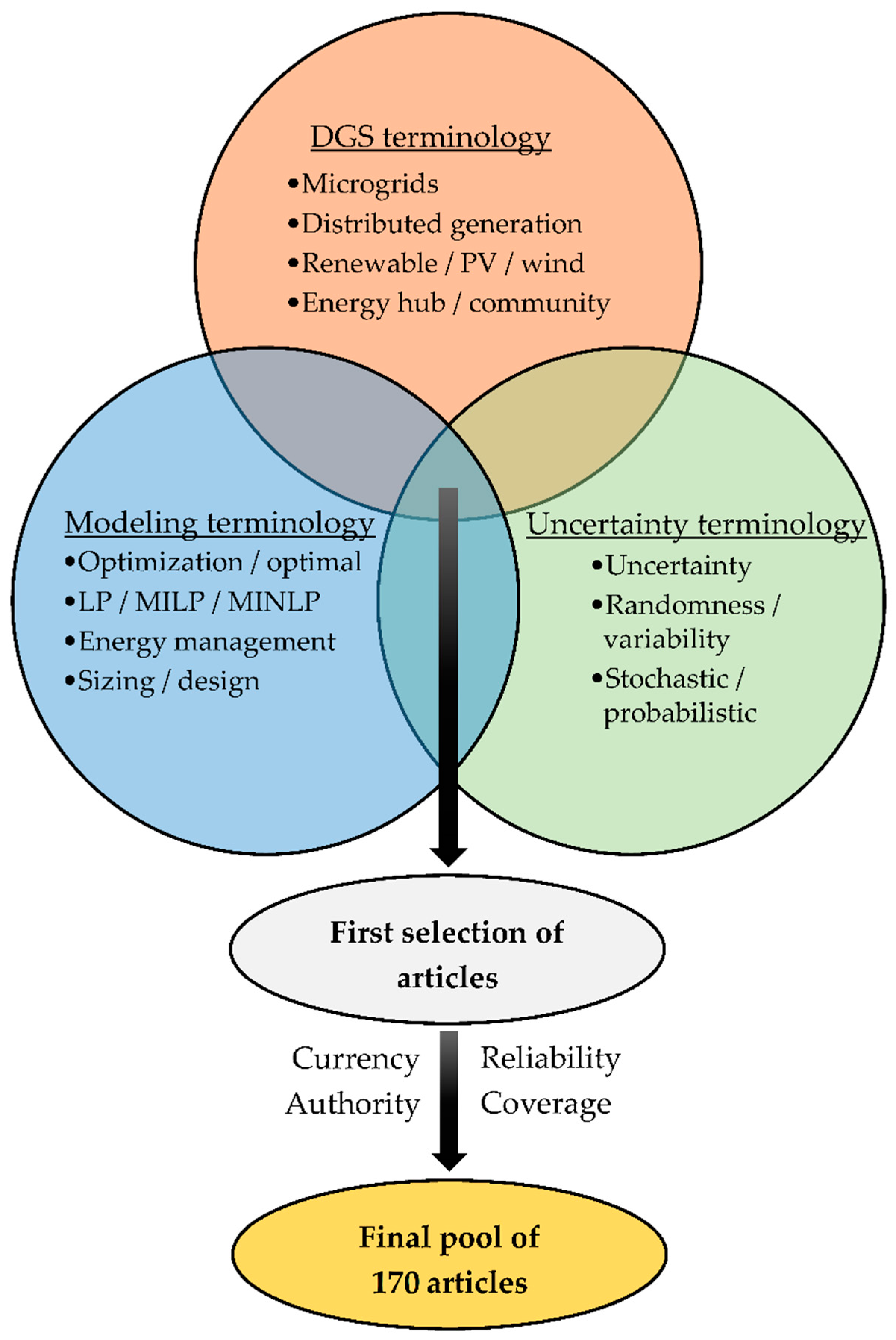
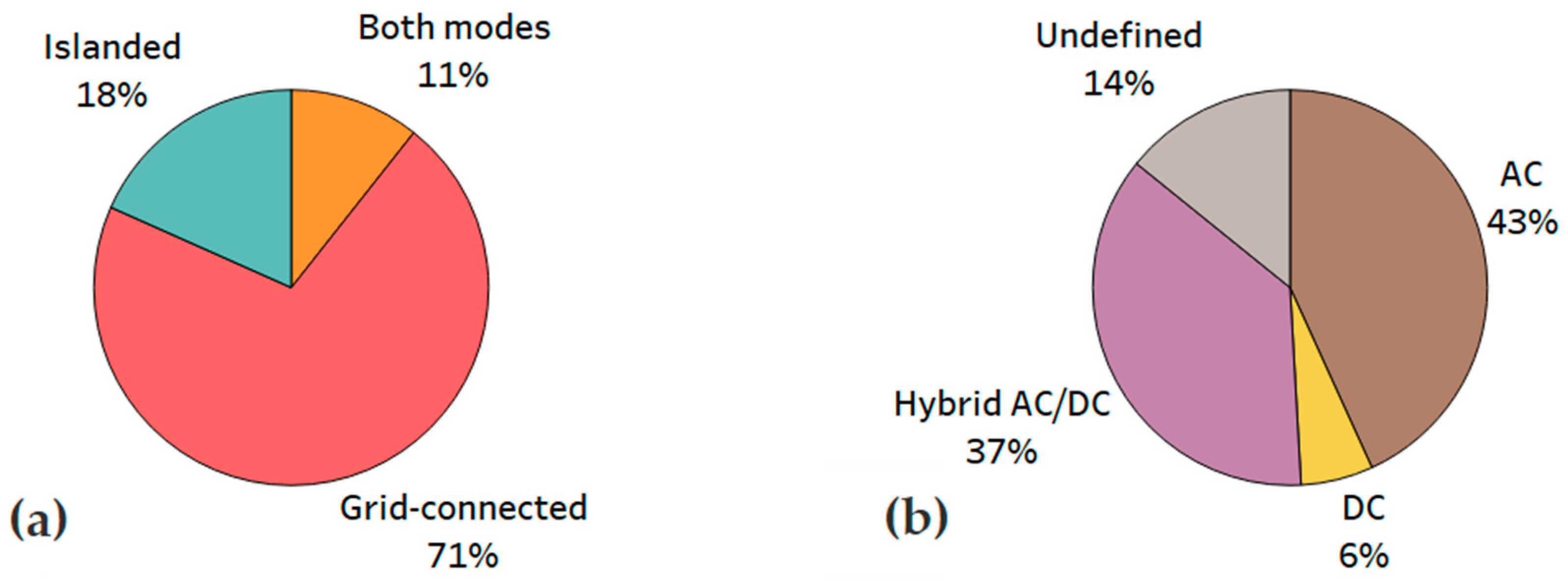
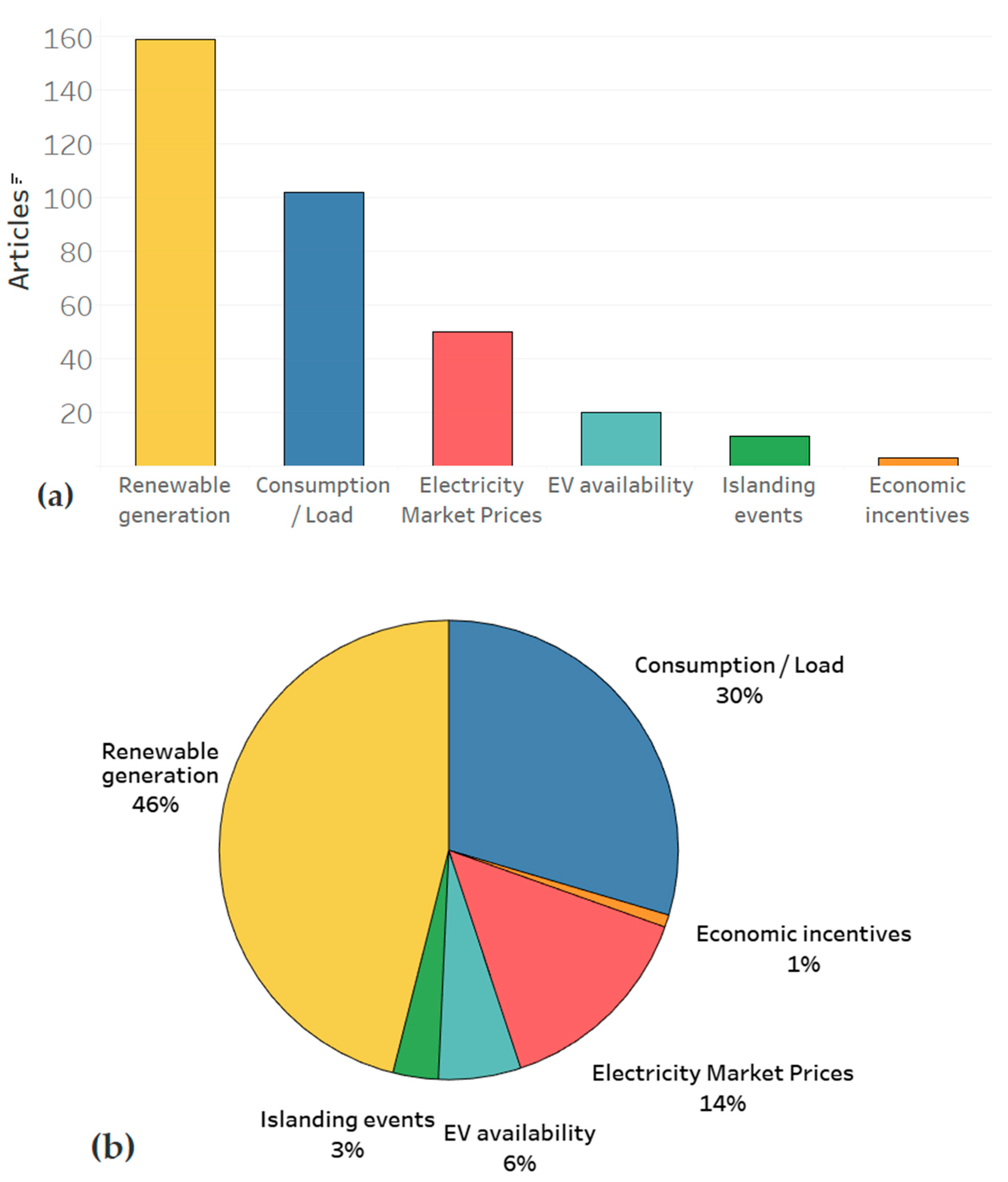

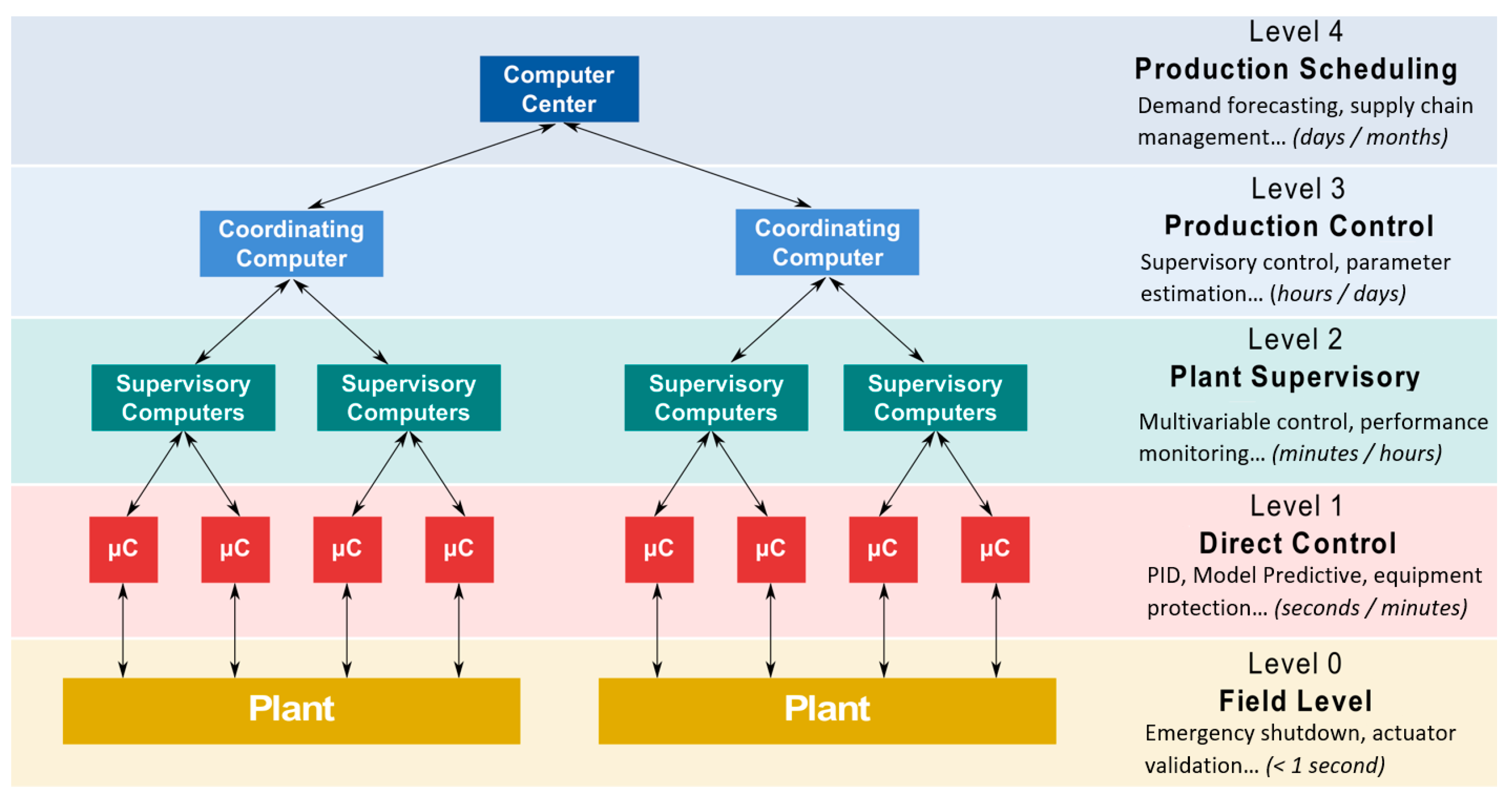

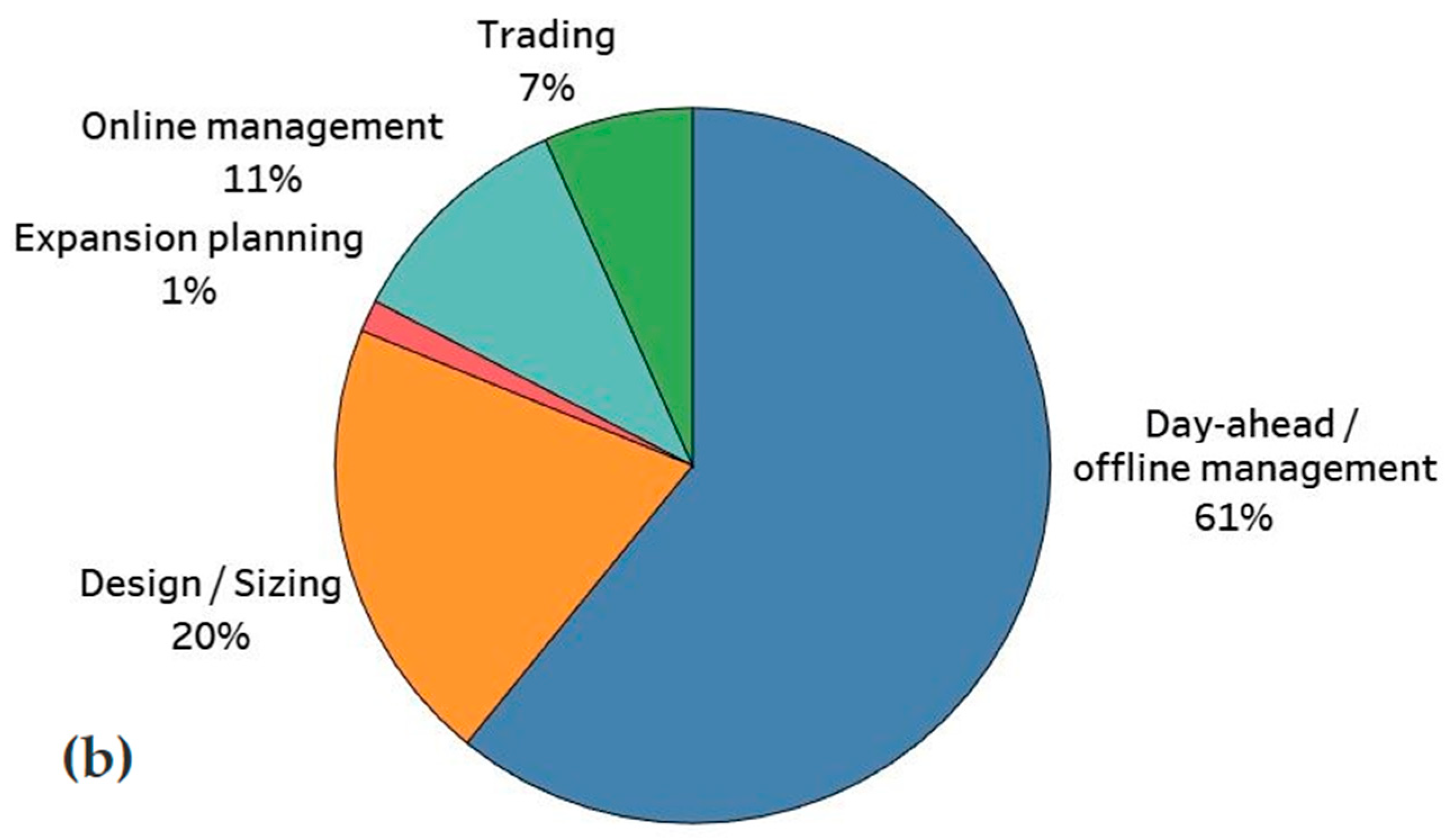
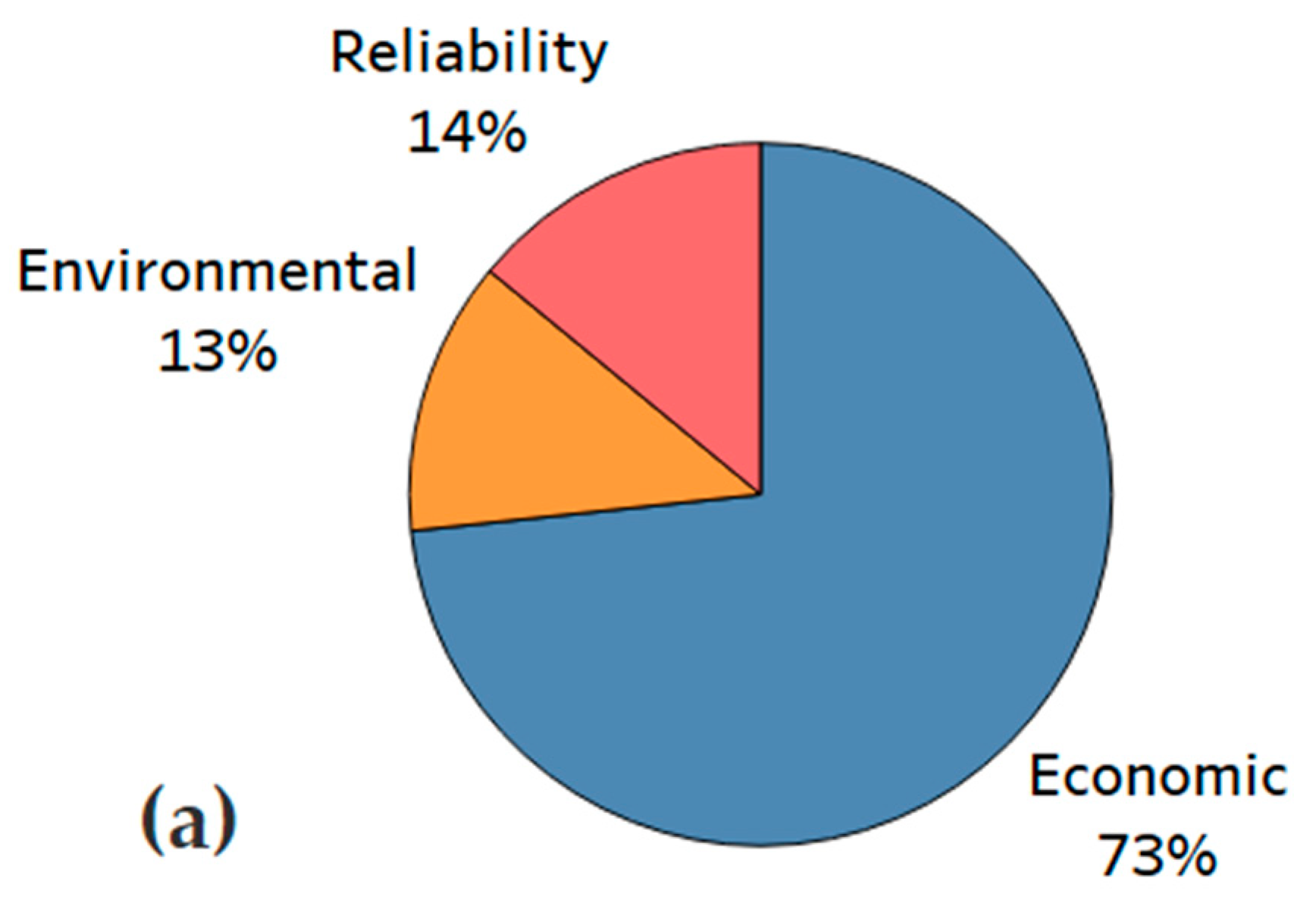
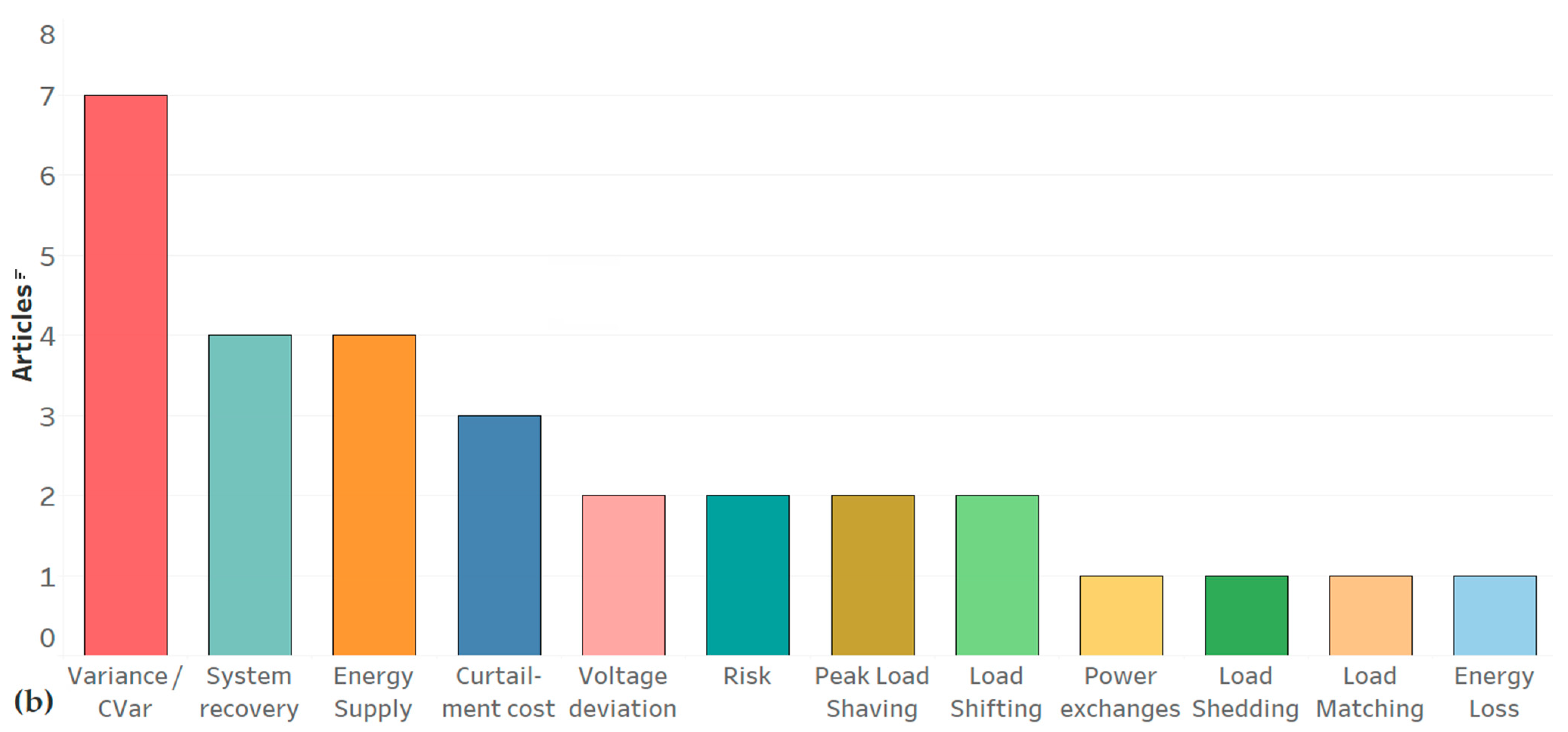
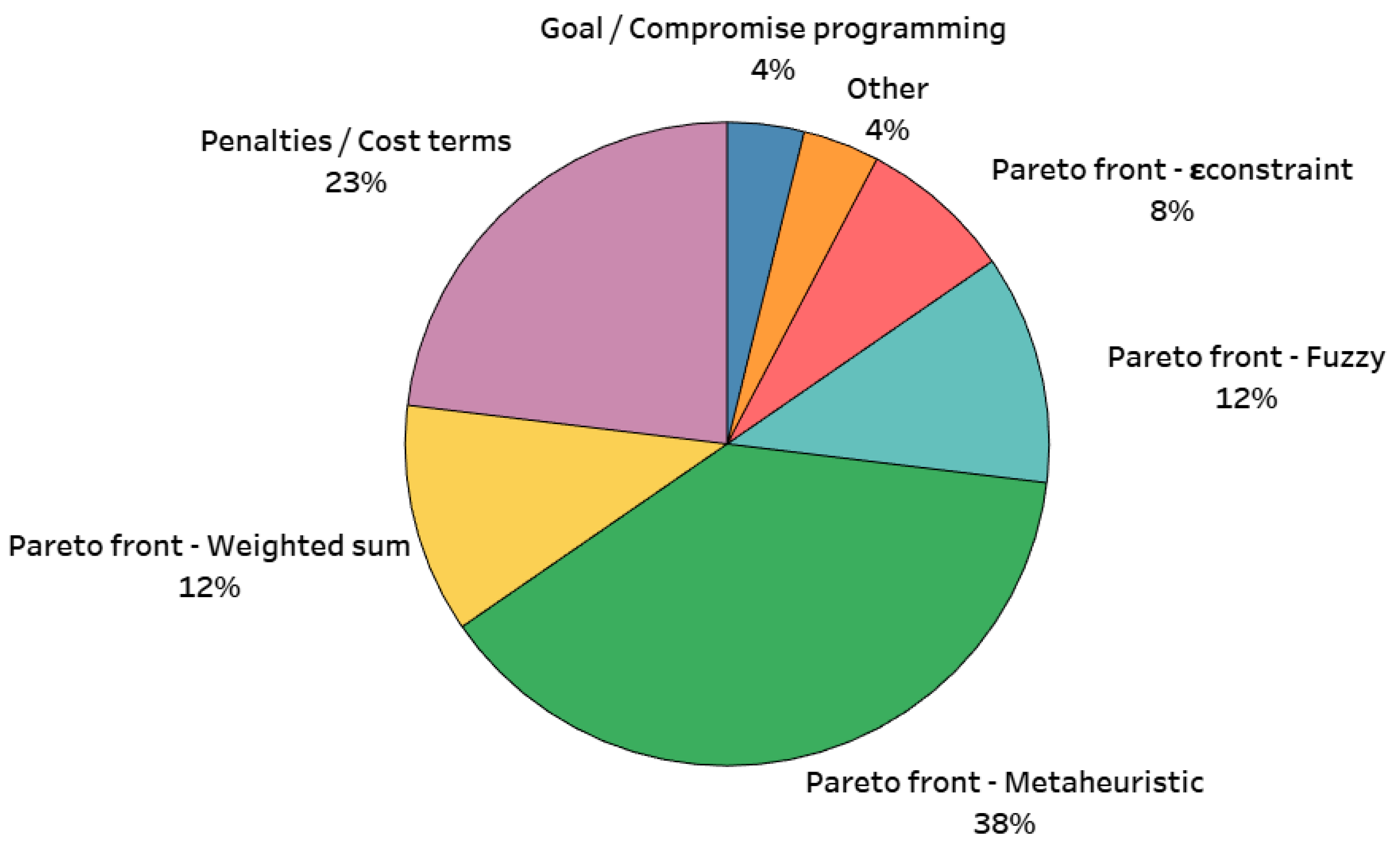

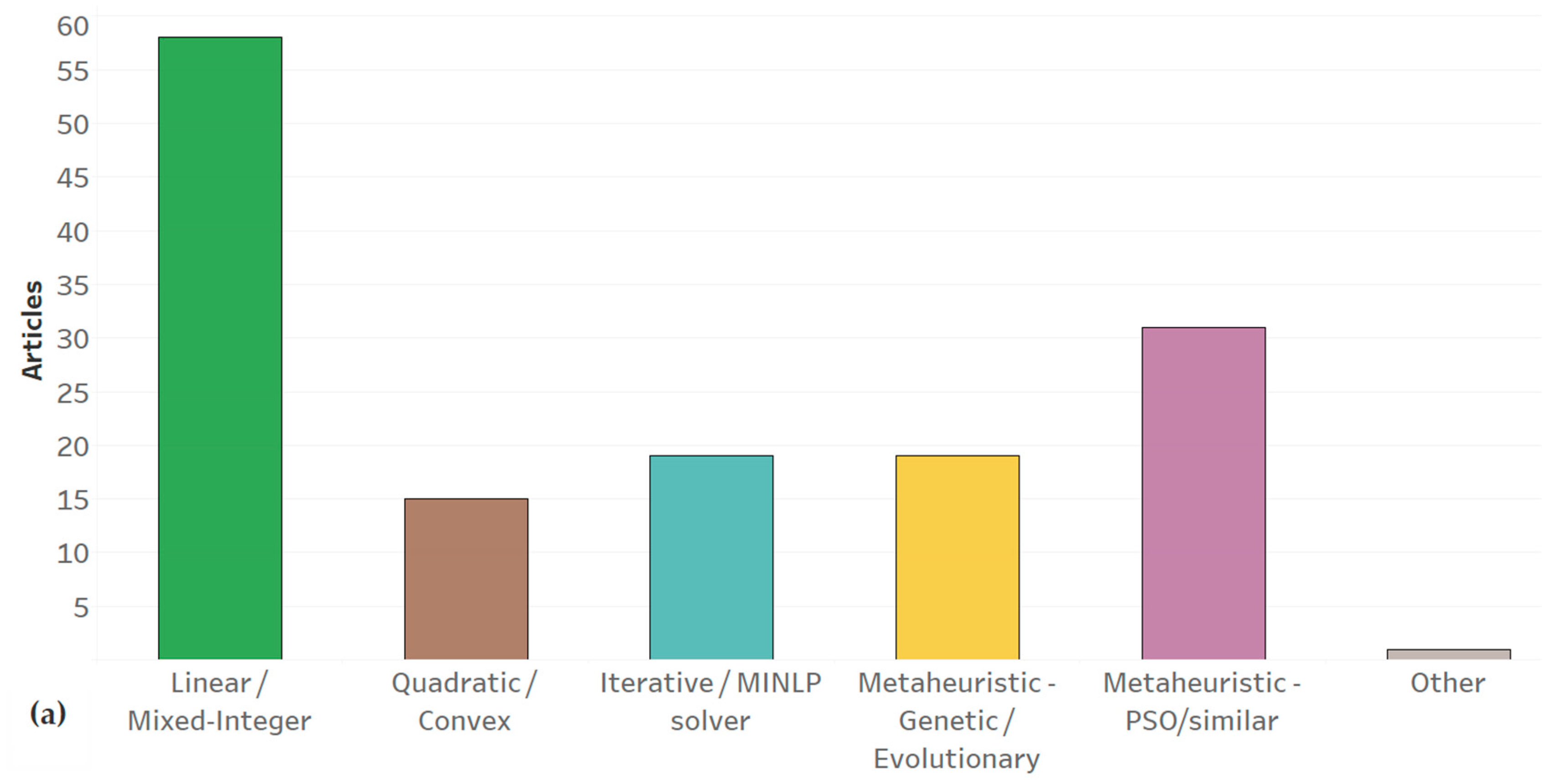
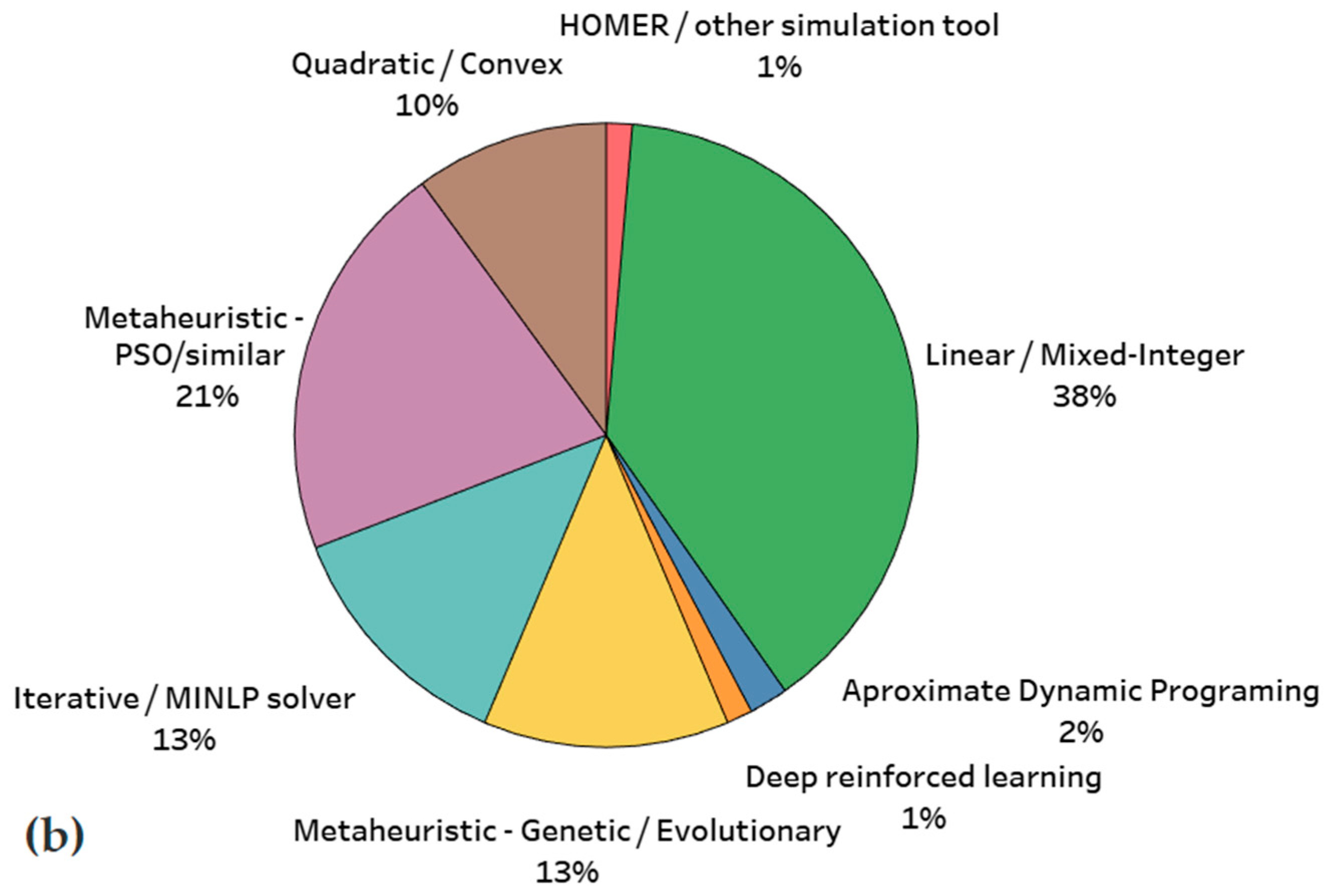
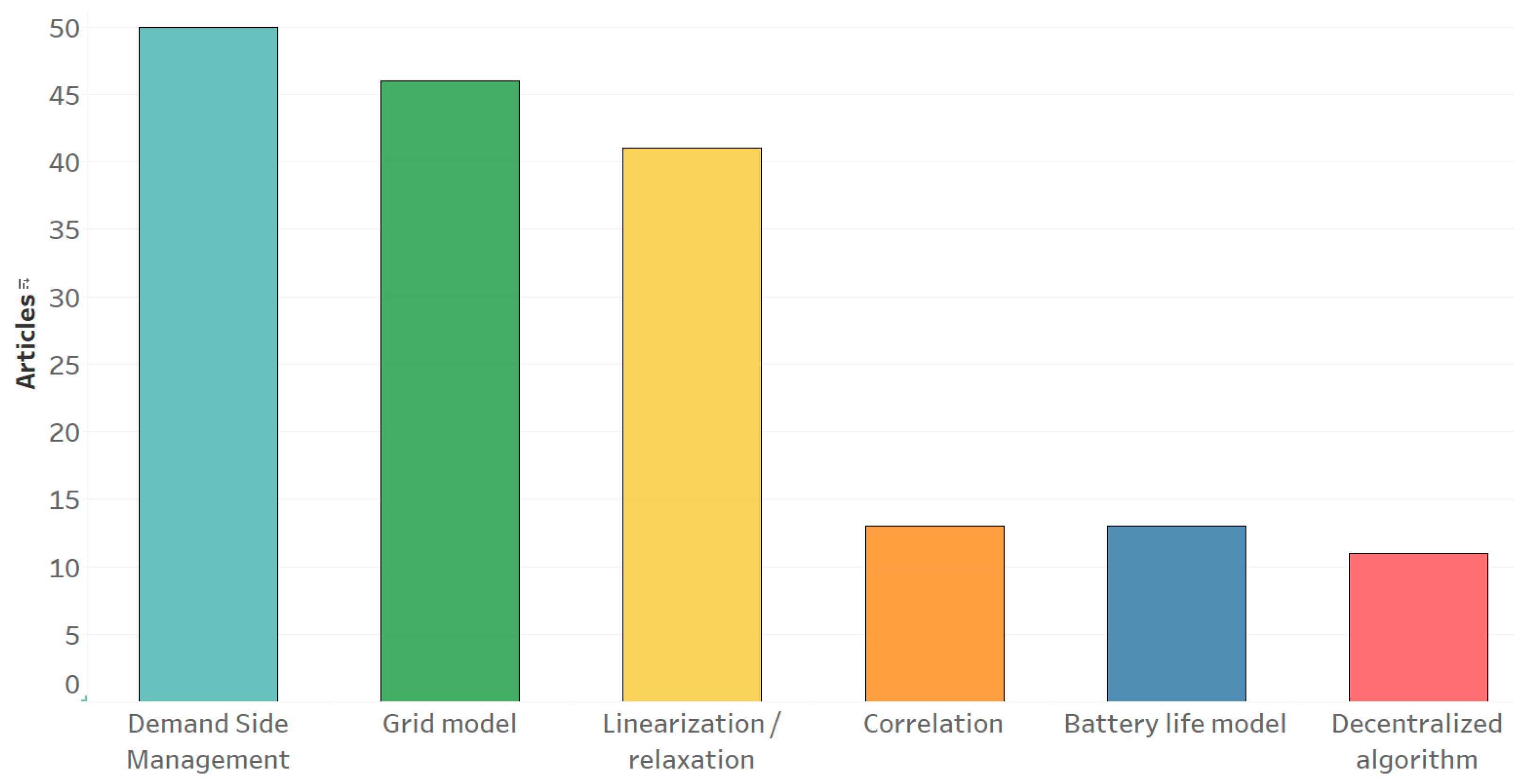
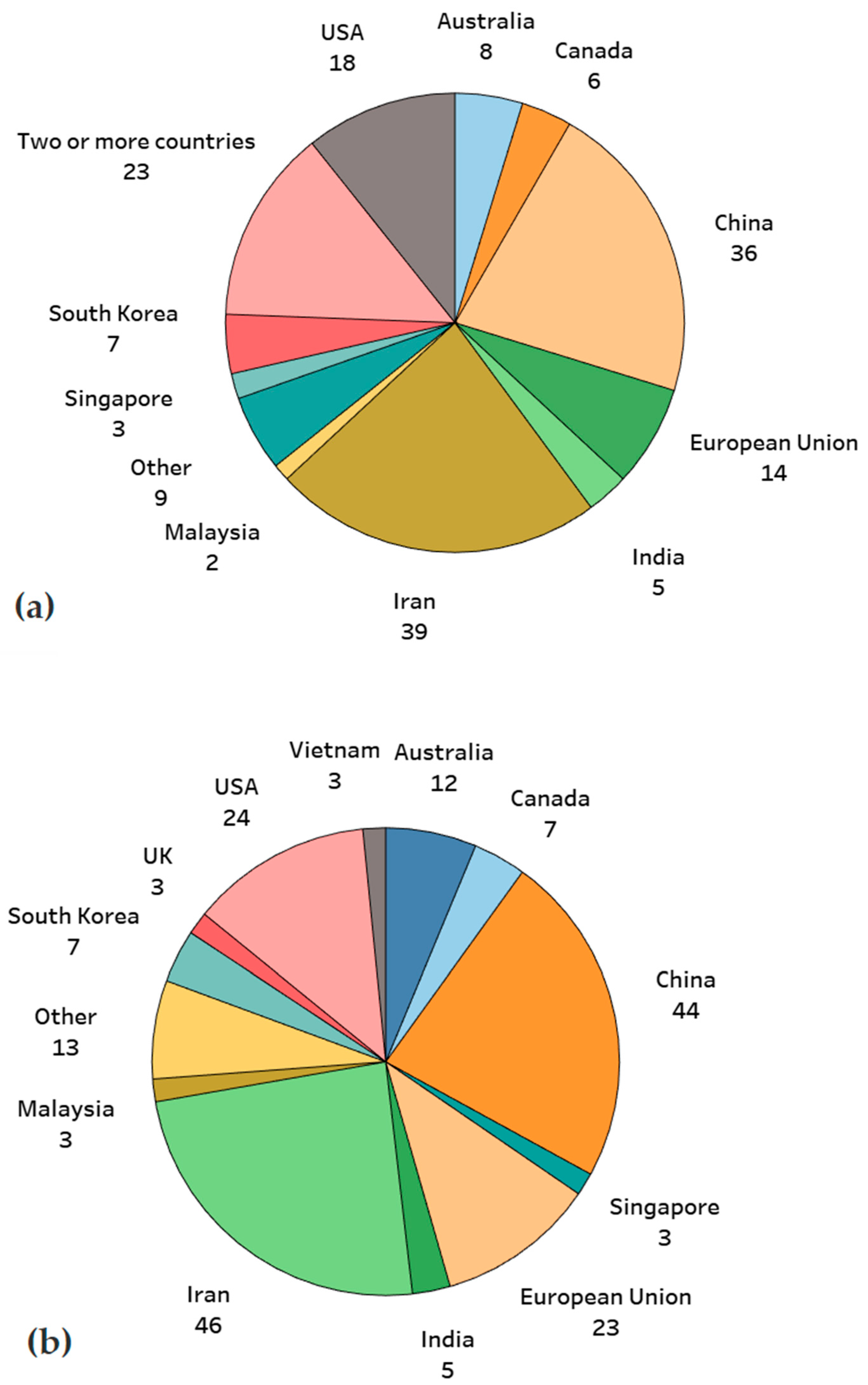
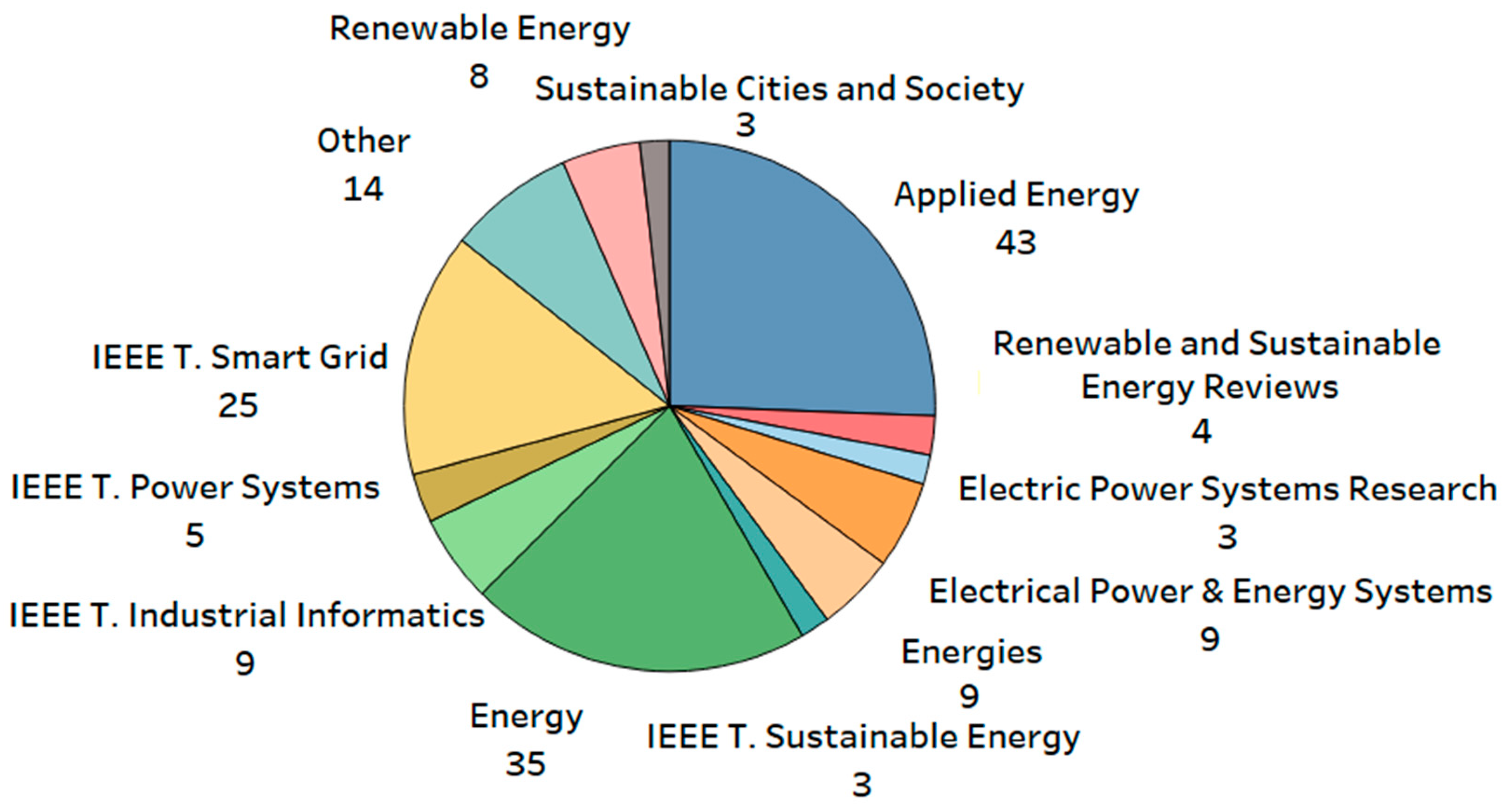
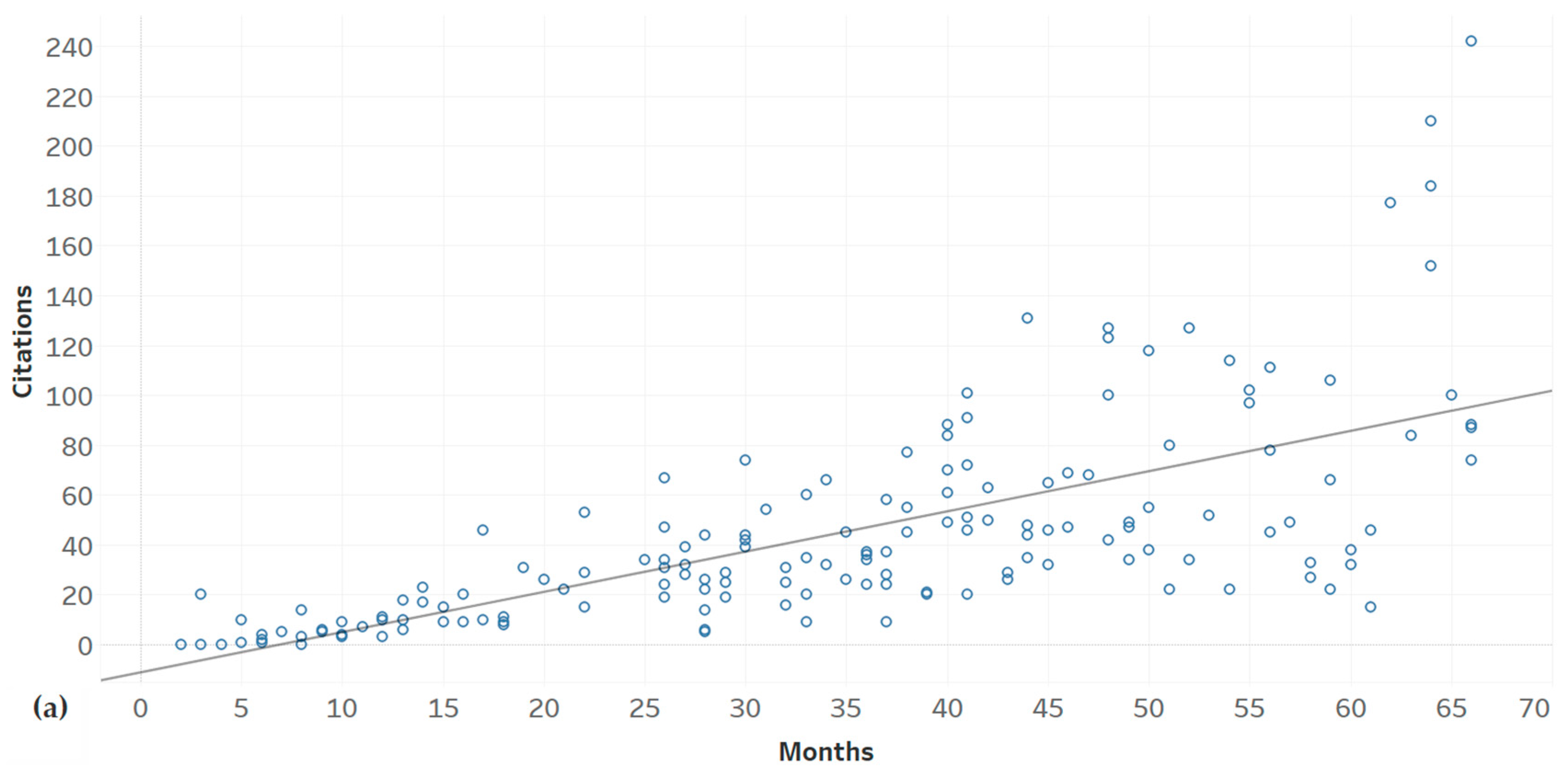
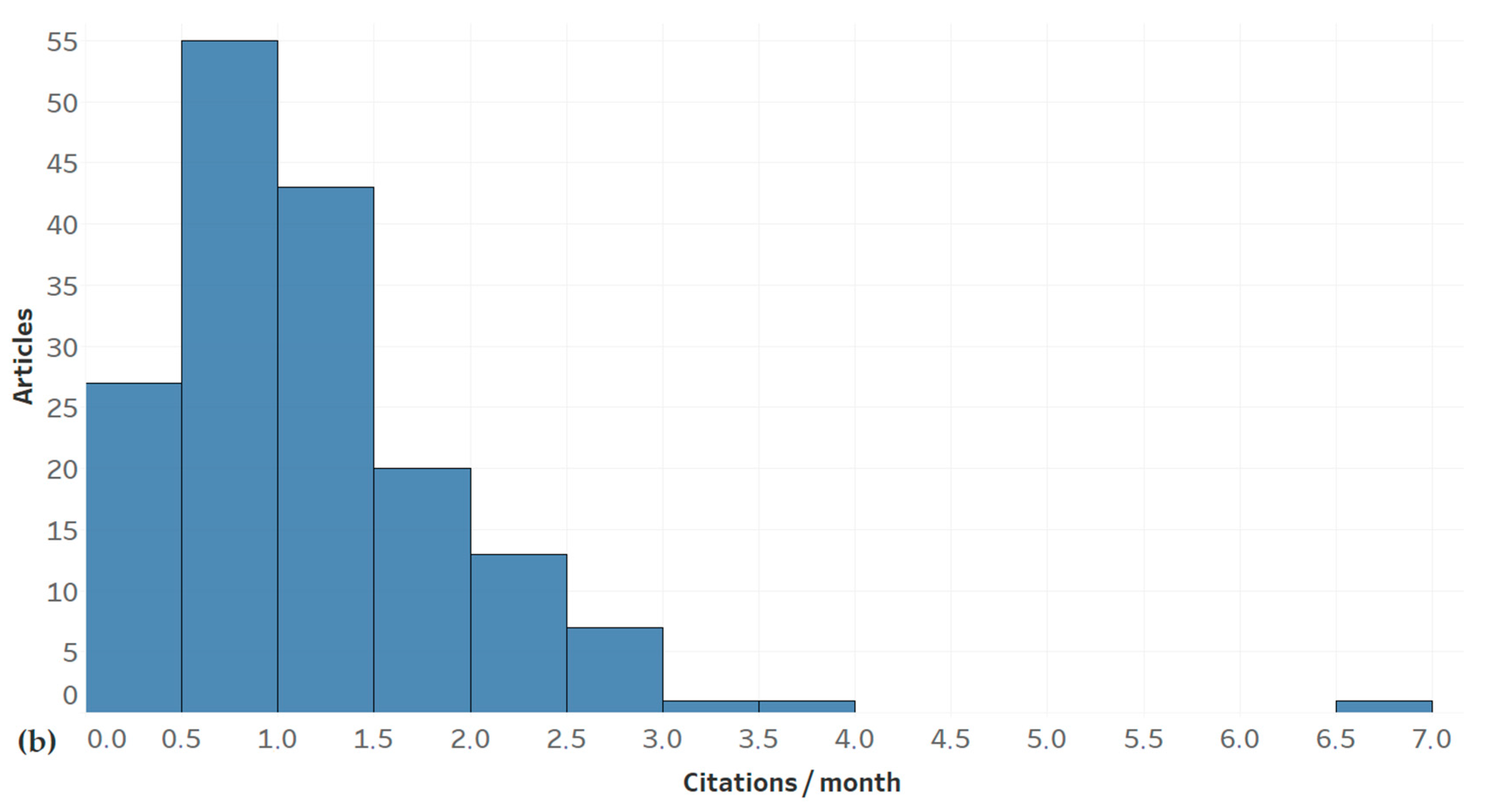
| Solar Irradiance | Wind Speed | Electricity Prices | Load | ||||
|---|---|---|---|---|---|---|---|
| Beta | Normal | Beta | Normal | Weibull | Normal | Normal | |
| [16] | X | X | |||||
| [18] | X | ||||||
| [20] | X | X | X | ||||
| [24] | X | X | X | ||||
| [25] | X | X | X | X | |||
| [33] | X | ||||||
| [49] | X | X | X | X | |||
| [57] | X | ||||||
| [74] | X | ||||||
| [77] | X | X | X | ||||
| [86] | X | X | |||||
| [88] | X | X | X | X | |||
| [89] | X | X | X | ||||
| [91] | X | X | X | ||||
| [94] | X | X | |||||
| [95] | X | X | |||||
| [96] | X | X | X | ||||
| [99] | X | X | X | ||||
| [103] | X | X | |||||
| [112] | X | X | |||||
| [115] | X | X | X | ||||
| [118] | X | ||||||
| [122] | X | X | X | ||||
| [139] | X | X | X | ||||
| [142] | X | X | |||||
| [149] | X | X | X | X | |||
| [151] | X | X | X | ||||
| [152] | X | ||||||
| [165] | X | X | X | ||||
| [167] | X | X | X | ||||
| [181] | X | X | X | ||||
| [182] | X | X | |||||
| [183] | X | X | |||||
| References | Time Span |
|---|---|
| [37,81,125] | <10 s |
| [68,109,125,179] | 10 s–1 min |
| [29,109,116] | 1 min |
| [109,137,160,174,181] | 5 min |
| [76,92,107,133,159,177] | 15 min |
| [42,66] | 30 min |
| [80,166] | 1 h |
| Stochastic Formulation | References |
|---|---|
| Scenario-based | [18,22,26,31,47,49,84,97,111,112,120,151,152,154,157,166,169,172] |
| 2SSP | [19,21,34,37,39,46,63,65,72,78,83,86,96,114,116,117,118,119,123,142,145,149,158,160,163,165,167,175,178,179] |
| MSSP | [17,33,41,42,60,77,94,99,121,140,170,173] |
| Robust Formulation | References |
|---|---|
| Robust programming | [36,37,39,43,51,53,58,59,61,67,70,73,76,79,86,90,101,104,110,117,124,128,129,130,134,136,161,162,163,168,177,178] |
| Chance constraints | [91,92,95,126,133,144] |
| Dynamic Formulation | References |
|---|---|
| RH | [22,35,36,37,66,74,75,78,96,98,103,112,131,133,135,156,166] |
| MPC | [38,52,57,66,102,109,115,125,126,146,147,181,182,183] |
| References | LP/MILP Solver | Simulation Platform |
|---|---|---|
| [19] | CPLEX | AIMMS |
| [17,21,22,36,53,58,65,84,86,99,115,117,134,136,142,151,154,157,176] | GAMS | |
| [37,44,83,96,101,128,129,130,156,160,161,170,179] | MATLAB | |
| [20,90,118,133,167] | IBM | |
| [116] | Gurobi | GAMS |
| [43] | MATLAB | |
| [82] | Python | |
| [145,166] | Intlinprog | MATLAB |
| [46,57,70] | Other/Unspecified | GAMS |
| [42,66,104,114,124,153,158] | MATLAB | |
| [30,41,75,92,126] | Unspecified |
| References | QP/CP Solver | Simulation Platform |
|---|---|---|
| [163] | CPLEX | GAMS |
| [70,144] | MATLAB | |
| [63] | CVX | MATLAB |
| [168] | Active set solver | MATLAB |
| [51,91,172] | Gurobi | MATLAB |
| [81] | Python | |
| [60] | MOSEK | Python |
| [29,107,109,127] | Other/Unspecified | Unspecified |
| Reference | MINLP Solver | Simulation Platform |
|---|---|---|
| [32,95,120] | BARON | GAMS |
| [39,120] | DICOPT | GAMS |
| [50,137] | Fmincon | MATLAB |
| [39,55,56,110,120] | SBB | GAMS |
| [77,149] | Other/Unspecified | GAMS |
| [26,71,152] | MATLAB | |
| [79,88,162,174,178] | Unspecified |
| Reference | Swarm-Based Algorithm |
|---|---|
| [85] | Ant lion algorithm |
| [34] | Competitive swarm optimization |
| [38,123] | Crow search algorithm |
| [64] | Cultural PSO co-evolutionary |
| [18] | Dragonfly algorithm |
| [24,132] | Firefly algorithm—modified |
| [164] | Flower pollination algorithm |
| [28] | Grasshopper optimization algorithm |
| [141] | Group search optimization |
| [45] | Imperialist competitive algorithm |
| [16,49,62,105,111,112,113,122,150,155,175] | PSO |
| [25,68,94,139] | PSO—modified |
| Reference | Genetic/Evolutionary Algorithm |
|---|---|
| [48] | Analog ensemble |
| [106] | Bat algorithm—modified |
| [23] | Bird-mating optimization |
| [23,139,169,184] | Differential evolution algorithm |
| [180] | Evolutionary predator and prey |
| [54,89] | Exchange market algorithm |
| [29,63,97,102] | Genetic algorithm |
| [100] | Harmony search algorithm |
| [31] | Krill herd algorithm—modified |
| [47,138] | NSGA-II |
| [76,122] | Rule-based/custom algorithm |
| [87] | Symbiotic organism search algorithm |
| [143] | Whale optimization algorithm |
| References | Testbed |
|---|---|
| [120,136] | CIGRE 13-bus |
| [81] | CIGRE 14-bus |
| [77] | IEEE 14-bus |
| [21,39,53,99,123,158,164,177,178] | IEEE 33-bus |
| [23,38,50,51,57,59,85,165,167,175] | Modified IEEE 33-bus |
| [47] | IEEE 34-bus |
| [107] | IEEE 37-bus |
| [43,52,54,170] | IEEE 69-bus |
| [118,181] | IEEE 118-bus |
| [109] | Modified IEEE 123-bus |
| [67,74,87,100,104,106,117,156] | Custom |
| [27,57,72,78,116,159] | Real-life setup |
| References | Battery Aging Model |
|---|---|
| [114] | Capacity fading coefficient |
| [61,88,101,104,124,158] | Degradation/aging cost (no cycle counting) |
| [105] | Exponential model |
| [98] | Linear degradation model |
| [29] | Multi-factor model |
| [34,113] | Rainflow counting algorithm |
| [102] | Semi-empirical model |
| References | Correlation Technique |
|---|---|
| [141] | Copulas |
| [166] | Gaussian mixture model |
| [44] | Heuristic moment matching |
| [52,85] | Modified PEM |
| [60,93,108,160,169,170] | Multivariable scenarios/profiles |
| [121,168] | Taguchi factorial design |
| [123] | Unscented transform |
| References | Linearization Technique |
|---|---|
| [17,22,38,58,73,78,118,134,136,158,161,167,181] | Auxiliary variables |
| [37,51,53,61,67,82,99,129,130,176] | Big m method |
| [43,51,60,170] | Convex relaxation |
| [52,163] | Diagonal quadratic approximation |
| [21,53,177] | Dual theory |
| [129,158] | Geometric approximation |
| [21,34,35,37,38,39,78,86,99,101,110,124,146,158,160] | Piecewise linear functions |
Publisher’s Note: MDPI stays neutral with regard to jurisdictional claims in published maps and institutional affiliations. |
© 2022 by the authors. Licensee MDPI, Basel, Switzerland. This article is an open access article distributed under the terms and conditions of the Creative Commons Attribution (CC BY) license (https://creativecommons.org/licenses/by/4.0/).
Share and Cite
Alonso-Travesset, À.; Martín, H.; Coronas, S.; de la Hoz, J. Optimization Models under Uncertainty in Distributed Generation Systems: A Review. Energies 2022, 15, 1932. https://doi.org/10.3390/en15051932
Alonso-Travesset À, Martín H, Coronas S, de la Hoz J. Optimization Models under Uncertainty in Distributed Generation Systems: A Review. Energies. 2022; 15(5):1932. https://doi.org/10.3390/en15051932
Chicago/Turabian StyleAlonso-Travesset, Àlex, Helena Martín, Sergio Coronas, and Jordi de la Hoz. 2022. "Optimization Models under Uncertainty in Distributed Generation Systems: A Review" Energies 15, no. 5: 1932. https://doi.org/10.3390/en15051932
APA StyleAlonso-Travesset, À., Martín, H., Coronas, S., & de la Hoz, J. (2022). Optimization Models under Uncertainty in Distributed Generation Systems: A Review. Energies, 15(5), 1932. https://doi.org/10.3390/en15051932






